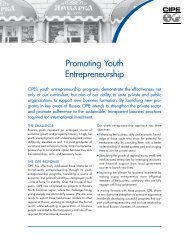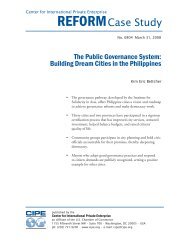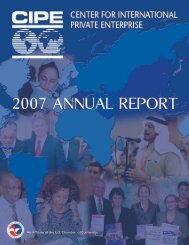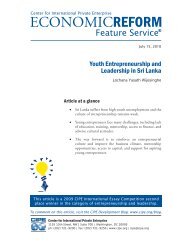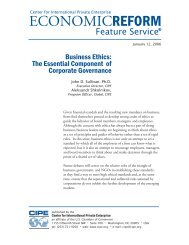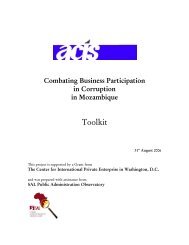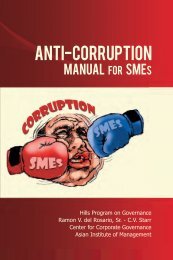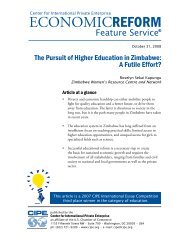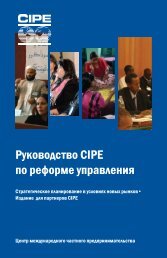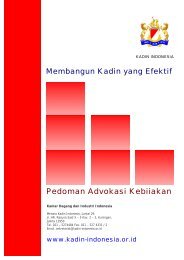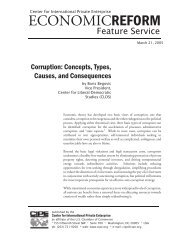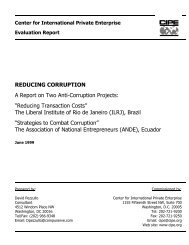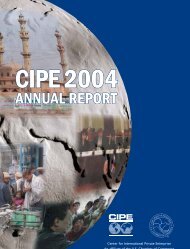A Resource Handbook for Economic and Business Journalists in ...
A Resource Handbook for Economic and Business Journalists in ...
A Resource Handbook for Economic and Business Journalists in ...
- No tags were found...
You also want an ePaper? Increase the reach of your titles
YUMPU automatically turns print PDFs into web optimized ePapers that Google loves.
A <strong>Resource</strong> <strong>H<strong>and</strong>book</strong> <strong>for</strong> <strong>Economic</strong><strong>and</strong> <strong>Bus<strong>in</strong>ess</strong> <strong>Journalists</strong> <strong>in</strong> PakistanCenter <strong>for</strong> International Private Enterprisean affiliate of the U.S. Chamber of Commerce
A <strong>Resource</strong> <strong>H<strong>and</strong>book</strong> <strong>for</strong> <strong>Economic</strong><strong>and</strong> <strong>Bus<strong>in</strong>ess</strong> <strong>Journalists</strong> <strong>in</strong> PakistanTable of ContentsPreface. . . . . . . . . . . . . . . . . . . . . . . . . . . . . . . . . 11 Introduction. . . . . . . . . . . . . . . . . . . . . . . . . . 32 <strong>Economic</strong>s - Is it News to You? . . . . . . . . . . . . . . . . . . . . .53 Glossary . . . . . . . . . . . . . . . . . . . . . . . . . . . . . . . . . . . . 164 List of <strong>Resource</strong>s . . . . . . . . . . . . . . . . . . . . . . . . . 36Center <strong>for</strong> International Private Enterprise
PrefaceOver the past four years, Pakistan has susta<strong>in</strong>ed an average economic growthrate of 7%, mak<strong>in</strong>g it one of the fastest grow<strong>in</strong>g economies <strong>in</strong> Asia. Thecountry’s grow<strong>in</strong>g emphasis on economic liberalization <strong>and</strong> privatization hashighlighted a need to exp<strong>and</strong> the scope <strong>and</strong> quality of <strong>in</strong><strong>for</strong>mation available toboth decision-makers <strong>and</strong> the public.The media has the responsibility, as well as the opportunity, to provide societywith objective, accurate, <strong>and</strong> timely <strong>in</strong><strong>for</strong>mation <strong>and</strong> thorough analysis ofeconomic trends <strong>and</strong> events. Today, there is a grow<strong>in</strong>g dem<strong>and</strong> <strong>in</strong> Pakistan <strong>for</strong>journalists with knowledge <strong>in</strong> the fields of economics <strong>and</strong> f<strong>in</strong>ance to <strong>in</strong>terpreteconomic <strong>in</strong><strong>for</strong>mation <strong>and</strong> present its implications to the public through variousmedia outlets.<strong>Economic</strong> <strong>and</strong> f<strong>in</strong>ancial reports, particularly <strong>in</strong> terms of pr<strong>in</strong>t media, generallyfocus on describ<strong>in</strong>g specific events without provid<strong>in</strong>g the background <strong>and</strong> analysisnecessary <strong>for</strong> the public to underst<strong>and</strong> the potential effects of new positionsor policies. Incomprehensible jargon is regularly used <strong>in</strong> news reports withoutan explanation of the context <strong>and</strong> mean<strong>in</strong>g of such words, thereby alienat<strong>in</strong>gord<strong>in</strong>ary readers or viewers by cater<strong>in</strong>g – <strong>in</strong>tentionally or otherwise – to thosealready <strong>in</strong>volved <strong>in</strong> bus<strong>in</strong>ess <strong>and</strong> f<strong>in</strong>ance.The Center <strong>for</strong> International Private Enterprise (CIPE) has partnered withthe Pakistan Press Foundation to leverage its expertise <strong>in</strong> this area <strong>and</strong> deliverneed-based journalist tra<strong>in</strong><strong>in</strong>g through an ongo<strong>in</strong>g series of workshops <strong>in</strong> cities<strong>H<strong>and</strong>book</strong> <strong>for</strong> <strong>Economic</strong> <strong>Journalists</strong> | 1
throughout Pakistan. These tra<strong>in</strong><strong>in</strong>g sessions will provide those <strong>in</strong> the mediawith additional <strong>in</strong><strong>for</strong>mation <strong>and</strong> skills to engage <strong>in</strong> substantive policy debates <strong>and</strong>work effectively with government <strong>and</strong> the bus<strong>in</strong>ess <strong>and</strong> f<strong>in</strong>ancial communities.In the course of design<strong>in</strong>g these tra<strong>in</strong><strong>in</strong>g sessions, CIPE discovered a need<strong>for</strong> a resource guide <strong>and</strong> glossary of economic <strong>and</strong> bus<strong>in</strong>ess term<strong>in</strong>ology withlocal content <strong>and</strong> references. This resource guide, created by CIPE <strong>and</strong> vettedby the Chartered F<strong>in</strong>ancial Analyst’s Association of Pakistan <strong>for</strong> its technicalcontent, will assist media professionals <strong>in</strong> underst<strong>and</strong><strong>in</strong>g how to present complexeconomic material at a level that is clear to all audiences. CIPE acknowledgesthe support provided by Mr. Kamal Siddiqui, a senior economic journalist, whoreviewed the publication <strong>and</strong> provided <strong>in</strong>put <strong>for</strong> editorial improvements.2 | Center <strong>for</strong> International Private Enterprise
IntroductionFree <strong>and</strong> unbiased bus<strong>in</strong>ess <strong>and</strong> economic report<strong>in</strong>g is essential <strong>for</strong> thedevelopment of democracy <strong>in</strong> Pakistan. Access to <strong>in</strong><strong>for</strong>mation is thefundamental right of every Pakistani <strong>and</strong> the press can play a vital role <strong>in</strong> thisregard. However, journalists <strong>in</strong> Pakistan often lack tra<strong>in</strong><strong>in</strong>g, lead<strong>in</strong>g to biased,<strong>in</strong>complete, or <strong>in</strong>accurate report<strong>in</strong>g that prompts readers <strong>and</strong> viewers to lose<strong>in</strong>terest <strong>in</strong> the story.<strong>Bus<strong>in</strong>ess</strong> <strong>and</strong> economic report<strong>in</strong>g is very different from report<strong>in</strong>g on crime, socialissues, enterta<strong>in</strong>ment, or political developments. If you turn to the bus<strong>in</strong>esspages of any daily newspaper or watch any bus<strong>in</strong>ess TV channel <strong>in</strong> Pakistan,you will f<strong>in</strong>d news on the stock market, <strong>in</strong>dustry, <strong>for</strong>eign exchange market, orthe economy <strong>in</strong> general. You will also see that most of these news items usebus<strong>in</strong>ess <strong>and</strong> economic jargon without giv<strong>in</strong>g the reader the context necessary tounderst<strong>and</strong> the story, thereby leav<strong>in</strong>g many questions unanswered <strong>in</strong> the m<strong>in</strong>dsof the audience. Millions of average Pakistani readers are the ma<strong>in</strong> consumerof these bus<strong>in</strong>ess stories, yet they are often unable to underst<strong>and</strong> what they read,see, <strong>and</strong> hear.This manual is not a comprehensive guide <strong>for</strong> the bus<strong>in</strong>ess journalist; rather, itis designed to give some guidel<strong>in</strong>es about the basics of bus<strong>in</strong>ess <strong>and</strong> economicreport<strong>in</strong>g. It will also suggest some easy ways to underst<strong>and</strong> the jargon <strong>and</strong>terms used <strong>in</strong> bank<strong>in</strong>g, bus<strong>in</strong>esses, commodities, <strong>in</strong>ternational markets, <strong>and</strong> theeconomy <strong>in</strong> general.<strong>H<strong>and</strong>book</strong> <strong>for</strong> <strong>Economic</strong> <strong>Journalists</strong> | 3
Organization of the <strong>H<strong>and</strong>book</strong>The h<strong>and</strong>book is divided <strong>in</strong>to two parts. The first part provides journalists withsome tips <strong>and</strong> techniques to improve bus<strong>in</strong>ess report<strong>in</strong>g skills. The second partconta<strong>in</strong>s a glossary of the most commonly used bus<strong>in</strong>ess terms used by Pakistanipublications. Wherever possible, useful website l<strong>in</strong>ks have been provided to helpreaders learn more about a particular term <strong>and</strong> its usage <strong>in</strong> Pakistan.AcknowledgementsThe glossary was compiled with the help of Wikipedia, the free onl<strong>in</strong>e encyclopedia.The author also consulted the <strong>Economic</strong> Survey of Pakistan (2005-06), the FederalBureau of Statistics website, the Annual Report of the State Bank of Pakistan(2004-05), <strong>and</strong> the website of the National Sav<strong>in</strong>gs Organization, M<strong>in</strong>istry ofF<strong>in</strong>ance, Government of Pakistan. Key onl<strong>in</strong>e resources are highlighted <strong>in</strong> thef<strong>in</strong>al section, List of <strong>Resource</strong>s.4 | Center <strong>for</strong> International Private Enterprise
<strong>Economic</strong>s - Is It News to You?<strong>Economic</strong> GobbledygookGobbledygook is a word that describes hard to underst<strong>and</strong>, obscure, <strong>and</strong>unnecessarily complicated language. The orig<strong>in</strong> of the word is particularlyillum<strong>in</strong>at<strong>in</strong>g when contemplat<strong>in</strong>g what economic jargon sounds like to the averagereader. In 1944, an American Congressman named Maury Maverick was tired ofoverly complicated government language. So, he concocted gobbledygook, a wordrem<strong>in</strong>iscent of the sound a turkey makes, which is called gobbl<strong>in</strong>g <strong>in</strong> English.The image of a turkey mak<strong>in</strong>g a sound no one can underst<strong>and</strong> br<strong>in</strong>gs to m<strong>in</strong>d the<strong>in</strong>decipherable jargon sometimes used <strong>in</strong> economic <strong>and</strong> bus<strong>in</strong>ess report<strong>in</strong>g.Some tips to help avoid gobbledygook <strong>in</strong> bus<strong>in</strong>ess <strong>and</strong> economic report<strong>in</strong>g:• Use pla<strong>in</strong> language that people use <strong>in</strong> normal conversation.• Remember that not only economists read the news! For average readers <strong>and</strong>viewers, economic gobbledygook is dull, bor<strong>in</strong>g, <strong>and</strong> confus<strong>in</strong>g.• Journalist should try to translate economic jargon by us<strong>in</strong>g simple, ord<strong>in</strong>arywords rather than opt<strong>in</strong>g <strong>for</strong> big words, complicated language, <strong>and</strong> run-onsentences.<strong>H<strong>and</strong>book</strong> <strong>for</strong> <strong>Economic</strong> <strong>Journalists</strong> | 5
Notes6 | Center <strong>for</strong> International Private EnterpriseLet’s look at this excerpt from a daily Pakistani newspaper report<strong>in</strong>g on the StateBank of Pakistan’s quarterly report as an example:Whereas an <strong>in</strong>crease of Rs103 billion <strong>in</strong> consumer loans was 22.7 percentof the <strong>in</strong>crease <strong>in</strong> overall loans, it was equal to only 11.4 percent of the totaloutst<strong>and</strong><strong>in</strong>g loans of Rs1,804 billion at the end of last fi scal year, up from 7.6percent a year earlier. Even then it was the third largest component of the banks’overall credit, after the corporate sector <strong>and</strong> small <strong>and</strong> medium size enterprises(SMEs). The corporate sector exhibited a reduced appetite <strong>for</strong> credit dur<strong>in</strong>g thelast fi scal year, though it received additional loans of Rs203 billion. At end-June 2004, the total outst<strong>and</strong><strong>in</strong>g corporate loans were worth Rs741 billion; theamount grew to Rs944 billion at end-June 2005...While an economist can easily underst<strong>and</strong> this k<strong>in</strong>d of language, the averagereader sees only gobbledygook. A journalist’s job is to break down the statistics<strong>and</strong> give the reader an idea of what it really means.The A B C’s – Decipher<strong>in</strong>g AcronymsAs a general rule, when referr<strong>in</strong>g to organizations, programs, or people,reporters should avoid the use of acronyms <strong>and</strong> abbreviations.<strong>Journalists</strong> need to give the full or partial name of an organization when referenc<strong>in</strong>git <strong>in</strong> a story. This clarifies the context <strong>for</strong> the reader <strong>and</strong> saves him/her the agonyof search<strong>in</strong>g the article to f<strong>in</strong>d the def<strong>in</strong>ition of a particular acronym. PEMRA,PTA, MCA, PPIB, PSEB, EDB, PNSC, NAFTA, SAFTA, SAARC, <strong>and</strong> otheracronyms will provide little help to average readers <strong>and</strong> viewers who are notfamiliar with economic or bus<strong>in</strong>ess abbreviations.Look at the follow<strong>in</strong>g excerpt taken from a daily Pakistani newspaper. Do youth<strong>in</strong>k this report<strong>in</strong>g style caters to the average reader? What might improve thispiece’s readability?…Pakistan Telecommunication Authority (PTA) is plann<strong>in</strong>g to <strong>in</strong>itiate a fi nalsurvey <strong>in</strong> the fi rst week of September <strong>for</strong> check<strong>in</strong>g the Quality of Service (QoS)of some cellular service provider companies across the country, sources close totelecom watchdog told newspaper. Sources <strong>in</strong><strong>for</strong>med this scribe that the telecomregulator (PTA) would <strong>in</strong>itiate a vigilant survey aga<strong>in</strong>st the poor service ofCellular Wireless <strong>and</strong> PhoneTel across the country. PTA had earlier issuedshow cause notices to the respective operators <strong>for</strong> their bad cellular service all overthe country. The telecom watchdog had recently warned Cellular Wireless thatit will slap a Rs350 million fi ne on it <strong>and</strong> term<strong>in</strong>ate its license if the mobilephone company does not respond to a show-cause notice with<strong>in</strong> 30 days. Thecompany then approached the telecom watchdog <strong>and</strong> a team of Cellular Wirelessoffi cials gave a detailed presentation about their cellular service but failed to getthe sympathies of the PTA...* Note: Names of the companies mentioned <strong>in</strong> the orig<strong>in</strong>al news item have been changed <strong>in</strong> thisexample.
NotesGive Them More, More, <strong>and</strong> MoreDefi ne <strong>and</strong> Expla<strong>in</strong><strong>Bus<strong>in</strong>ess</strong> <strong>and</strong> economic terms can be hard to avoid, yet def<strong>in</strong><strong>in</strong>g them posesthe threat of over-simplification. Some tips <strong>for</strong> journalists on how to walkthat delicate balance:• Clarity <strong>in</strong> report<strong>in</strong>g is more important than brevity.• Try to def<strong>in</strong>e every bus<strong>in</strong>ess <strong>and</strong> economic term, even common ones, to helpreaders or viewers.• Create a list of brief def<strong>in</strong>itions to expla<strong>in</strong> economic term<strong>in</strong>ology <strong>and</strong> <strong>in</strong>sertit <strong>in</strong>to the story. This helps the readers get a complete picture.• When compos<strong>in</strong>g a news piece, the journalist should reference the h<strong>and</strong>book’sglossary, consult bus<strong>in</strong>ess <strong>and</strong> economics dictionaries, or visit websites suchas those referenced <strong>in</strong> the <strong>in</strong>troduction to ensure that he/she has a completeunderst<strong>and</strong><strong>in</strong>g of the ideas.See how a reporter expla<strong>in</strong>ed the gross domestic product (GDP) of Ch<strong>in</strong>a <strong>in</strong> asfew words as possible:<strong>Economic</strong> growth <strong>in</strong> Ch<strong>in</strong>a strengthened <strong>in</strong> early 2006, despite attempts byCh<strong>in</strong>a’s government to slow economic activity to a more susta<strong>in</strong>able pace dur<strong>in</strong>g2005. Gross domestic product, the broadest measure of economic activity, reached4.33 trillion Yuan (about US$540 billion) <strong>in</strong> the March quarter 2006…Numbers, Figures, <strong>and</strong> StatisticsSimplify StatisticsBelow is an excerpt from a Pakistani daily newspaper:In spite of a Rs60 billion rise <strong>in</strong> its deposit base over June 2005, the half-yearprofi t paid by one of the big banks rose by only Rs1.98 billion refl ect<strong>in</strong>g a rise ofslightly over 0.8 percent per annum on the average of its clos<strong>in</strong>g deposit fi gures atthe end of the fi rst half of 2005 <strong>and</strong> 2006. Based on the same <strong>for</strong>mula, <strong>in</strong> caseof another big bank (whose deposit base rose by Rs27 billion over 2005), profi tpayment on deposits rose by just 0.63 percent per annum. Based on the 2006half year fi gures, the annualized return on equity of the big fi ve ranges between21.45 <strong>and</strong> 50.74 percent.For an economist, underst<strong>and</strong><strong>in</strong>g the above passage is <strong>in</strong>tuitive. But does it makesense to the average reader? The story is about the bank<strong>in</strong>g sector’s excessive<strong>H<strong>and</strong>book</strong> <strong>for</strong> <strong>Economic</strong> <strong>Journalists</strong> | 7
Notesprofits. For the average reader, statistics are an alien language. The reporter’s jobis to put the statistics <strong>in</strong> context <strong>and</strong> expla<strong>in</strong> why these changes are important.After writ<strong>in</strong>g an economic piece, the reporter needs to ask him/herself, “Whatdoes this mean?” Then the reporter should put him/herself <strong>in</strong> the shoes of theaverage reader <strong>and</strong> ask aga<strong>in</strong>, “What does this mean?” These answers need to beclearly expressed <strong>in</strong> the news item.In bus<strong>in</strong>ess news <strong>and</strong> stories, the precision <strong>and</strong> accuracy of the reported data ishighly significant. However, most of the time journalists make the fatal mistakeof br<strong>in</strong>g<strong>in</strong>g <strong>in</strong> too many statistics. This clutters the story <strong>and</strong> loses the reader’s<strong>in</strong>terest by <strong>in</strong>troduc<strong>in</strong>g <strong>in</strong>timidat<strong>in</strong>g numbers <strong>and</strong> figures (see the above passage),thereby discourag<strong>in</strong>g readers <strong>and</strong> viewers from f<strong>in</strong>ish<strong>in</strong>g the piece. The follow<strong>in</strong>gare some tips <strong>for</strong> journalists on how to organize the statistics:• Do not report numbers by themselves. Numbers only have mean<strong>in</strong>g <strong>in</strong>context.• Too many numbers <strong>and</strong> statistics overwhelm the readers <strong>and</strong> viewers,becom<strong>in</strong>g daunt<strong>in</strong>g <strong>and</strong> difficult to comprehend.• Avoid us<strong>in</strong>g figures that are not crucial to the story.• Rather than list<strong>in</strong>g statistics, present data <strong>in</strong> the <strong>for</strong>m of charts, tables, <strong>and</strong>graphs. Television anchorpersons on bus<strong>in</strong>ess programs should develop thehabit of us<strong>in</strong>g charts <strong>and</strong> graphs <strong>in</strong> their programs.• Numbers <strong>and</strong> figures us<strong>in</strong>g decimals appear more menac<strong>in</strong>g. Round<strong>in</strong>g themoff makes them less <strong>in</strong>timidat<strong>in</strong>g. It is important to note, however, thatsome figures require accuracy <strong>and</strong> precision – every decimal po<strong>in</strong>t counts.For example, if the news says that the State Bank of Pakistan <strong>in</strong>creased itsdiscount rate by approximately 0.5% when it actually <strong>in</strong>creased by 0.45%, thedifference is significant <strong>for</strong> the f<strong>in</strong>ancial sector. Reporters must decide, basedon their probable audience, when it is appropriate to round <strong>and</strong> when exactfigures must be ma<strong>in</strong>ta<strong>in</strong>ed.• It is a good idea to <strong>in</strong>clude additional <strong>in</strong><strong>for</strong>mation regard<strong>in</strong>g figures <strong>and</strong>statistics at the end of the story <strong>for</strong> those who are <strong>in</strong>terested <strong>in</strong> them. Mostreaders <strong>and</strong> viewers will have a limited <strong>in</strong>terest <strong>in</strong> the figures, preferr<strong>in</strong>g<strong>in</strong>stead to know what the figures mean <strong>for</strong> the economy as a whole.• When report<strong>in</strong>g statistics, it is always better to have an explicit comparison toother numbers to demonstrate their relative worth, such as a comparison tothe previous fiscal year or the previous quarter.8 | Center <strong>for</strong> International Private Enterprise
Notes• A reporter should ask questions when gather<strong>in</strong>g statistics <strong>in</strong> order to ga<strong>in</strong>a full underst<strong>and</strong><strong>in</strong>g of the number’s mean<strong>in</strong>g <strong>and</strong> significance. How doesthis number compare to other cities, other prov<strong>in</strong>ces, other countries, evenother eras? How does this number compare to total spend<strong>in</strong>g, spend<strong>in</strong>g onnecessities, spend<strong>in</strong>g on luxuries, spend<strong>in</strong>g on other k<strong>in</strong>ds of goods? Thisemphasizes the reporter’s analytical skills <strong>and</strong> makes the reporter a moretrustworthy news emissary <strong>for</strong> the public.• A journalist should ensure that all figures are correct <strong>and</strong> have them doublecheckedto avoid errors.Below is excerpt from a Pakistani daily newspaper, with figures shown <strong>in</strong>comparison to the fiscal years. In this selection, the author clearly describes therelevant statistics by giv<strong>in</strong>g them context <strong>and</strong> us<strong>in</strong>g them as the basis <strong>for</strong> his f<strong>in</strong>alconclusion.Story TimeThe Karachi city population, which stood at a mere 200,000 <strong>in</strong> 1947 had,accord<strong>in</strong>g to the 1998 census, soared to nearly 9.6 million <strong>in</strong> 1998 <strong>and</strong> is nowestimated to have swelled to 13.4 million <strong>in</strong> 2005. Truly, it has become an<strong>in</strong>dustrial, fi nancial <strong>and</strong> commercial centre <strong>and</strong> contributes nearly 56 percent <strong>in</strong>overall federal tax revenues.Create a story around numbersReporters should recognize that while numbers may support an argument,they are generally not the whole story. Numbers are mean<strong>in</strong>gless whenthey are just numbers; a news piece should provide context, the sett<strong>in</strong>g, <strong>and</strong>an explanation <strong>for</strong> the figures. Here are some tips on fram<strong>in</strong>g a story aroundnumbers:• The reporter should analyze the facts <strong>and</strong> figures, try to identify the purposeof the story, <strong>and</strong> ask, “What is the story <strong>in</strong> the numbers? What is happen<strong>in</strong>gwith these figures?”• When journalists write about trade, taxes, <strong>and</strong> other numbers <strong>in</strong> billions ormillions, they become mean<strong>in</strong>gless to the readers unless they are be<strong>in</strong>g used<strong>in</strong> some context.• Remember, bus<strong>in</strong>ess report<strong>in</strong>g is not just <strong>for</strong> economists. A reporter needsto expla<strong>in</strong> the mean<strong>in</strong>g of statistics <strong>in</strong> the lead or beg<strong>in</strong>n<strong>in</strong>g of the story – theactual figures can come later.<strong>H<strong>and</strong>book</strong> <strong>for</strong> <strong>Economic</strong> <strong>Journalists</strong> | 9
NotesHere is an excerpt that highlights the importance of ask<strong>in</strong>g these questions:The fi gures recently released by the government suggest that the economic growthlooks promis<strong>in</strong>g, with growth fi gures touch<strong>in</strong>g 5%, <strong>in</strong>fl ation rate at 6.5%, theunemployment rate stood at 5%, <strong>and</strong> the budget defi cit around 1.5%...The reporter needs to ask first, “What is happen<strong>in</strong>g here? Is the above per<strong>for</strong>mancegood or bad? In comparison to what?” The reporter needs to th<strong>in</strong>k like a readeror a viewer. How could the reporter <strong>in</strong>terpret the <strong>in</strong>complete <strong>in</strong><strong>for</strong>mation above<strong>in</strong> order to expla<strong>in</strong> it more effectively? Below is an improved version of theabove passage. In this version, the readers are <strong>in</strong> a better position to judge theper<strong>for</strong>mance of the economy. What are some other ways this snippet could beimproved <strong>for</strong> greater underst<strong>and</strong><strong>in</strong>g?The government claims that <strong>for</strong> the fi scal year 2006-07, the outlook on economicgrowth looks good. The economy is likely to grow by 5% this year, signifi cantlyup from last year’s rate of 3.5% (2005-06). The <strong>in</strong>fl ation rate is expected tofall to 6.5%, down from 7% last year. As a result of growth, the unemploymentrate will drop to a record low 5% down from 5.5% last year, <strong>and</strong> the budgetdefi cit is likely to improve this year to 1.5% from 2.5% last year.Report<strong>in</strong>g the Full StoryConsider<strong>in</strong>g other perspectives, alternatives, <strong>and</strong> sides to a storyAjournalist’s job is to report the news as objectively as possible. No reporter canbe completely impartial, however, <strong>and</strong> bus<strong>in</strong>ess stories are often concludedwith a reference to the journalist’s <strong>in</strong>dividual op<strong>in</strong>ion. An ef<strong>for</strong>t to present everyside of the story can elim<strong>in</strong>ate reporter bias <strong>in</strong> bus<strong>in</strong>ess stories. <strong>Journalists</strong> needto build credibility <strong>in</strong> the m<strong>in</strong>ds of their readers <strong>and</strong> viewers. They can do this bypresent<strong>in</strong>g all sides of a story <strong>and</strong> leav<strong>in</strong>g the f<strong>in</strong>al <strong>in</strong>terpretation to the readers.Some tips <strong>for</strong> journalist objectivity are given below:• Do not tell just half of the story.• Do not hide one side of the story.• Try to f<strong>in</strong>d all the characters of the story, all the stakeholders, all theparticipants <strong>in</strong> the market, <strong>and</strong> all the people that matter. There are consumers<strong>and</strong> producers, bosses <strong>and</strong> workers, partners <strong>and</strong> competitors, locals <strong>and</strong><strong>for</strong>eigners – <strong>and</strong> all these groups must be consulted when develop<strong>in</strong>g a piece.Try to obta<strong>in</strong> <strong>in</strong><strong>for</strong>mation on supply <strong>and</strong> dem<strong>and</strong>, wages <strong>and</strong> profits, costs<strong>and</strong> prices, etc., <strong>in</strong> order to supply the reader with different op<strong>in</strong>ions <strong>and</strong>angles.10 | Center <strong>for</strong> International Private Enterprise
Notes• Ask experts what their opponents would say on the issue. The reportershould not advocate <strong>for</strong> an issue unless he/she can make a strong case <strong>for</strong>the other side as well.• The reporter needs to underst<strong>and</strong> that some people may disagree with his/her analysis.And…Action!F<strong>in</strong>d the human angle <strong>in</strong> each storyOften, journalists assume that bus<strong>in</strong>ess report<strong>in</strong>g is all about numbers,figures, economics, <strong>and</strong> executives. Too often, the average people are<strong>for</strong>gotten. People want to know how economic statistics <strong>and</strong> developments willaffect them. A reporter should always ask, “What consequences will this eventhave <strong>for</strong> Pakistanis? What substance <strong>and</strong> human element does this story have?”Below is an excerpt about the famous sugar scam, taken from a daily Pakistan<strong>in</strong>ewspaper.The Monopoly Control Authority (MCA) has found 28 sugar mills – some ofthem owned by politicians <strong>and</strong> <strong>in</strong>dustry tycoons – <strong>in</strong>volved <strong>in</strong> hoard<strong>in</strong>g of sugar,sources told this scribe. The MCA has directed these mills to make their stocksavailable with<strong>in</strong> a month so that the high prices of sugar could be brought down.“The <strong>in</strong>fl uential sugar <strong>in</strong>dustry tycoons will have to comply with the MCA orders<strong>and</strong> <strong>in</strong> case of non-compliance strict legal action will be taken,” a high-leveloffi cial said here...What makes this piece <strong>in</strong>terest<strong>in</strong>g? It:• Hooks readers by giv<strong>in</strong>g them real-life stories on which to focus.• Uses anecdotes to lead <strong>in</strong>to the story – it will help readers <strong>and</strong> viewers relateto the topic.• Pa<strong>in</strong>ts a picture <strong>in</strong> the readers’ m<strong>in</strong>ds by giv<strong>in</strong>g them the facts, details, <strong>and</strong>descriptions of the events <strong>and</strong> people that matter <strong>in</strong> the story.For example, news about the price of public transportation, petrol, food, cars,utilities, taxes has a direct or an <strong>in</strong>direct l<strong>in</strong>k to the readers. Any story <strong>in</strong>volv<strong>in</strong>ga consumer product will affect readers on a personal level.<strong>H<strong>and</strong>book</strong> <strong>for</strong> <strong>Economic</strong> <strong>Journalists</strong> | 11
NotesOut to Be a Trendsetter?Remember, do not report fake trendsWhile anecdotes are a useful lead-<strong>in</strong> to the story, sometimes reporters gooverboard <strong>and</strong> relate facts that are far-fetched or simply untrue.• Anecdotes should only be used when they are applicable <strong>and</strong> are not grosslyunrepresentative of the issue at h<strong>and</strong>.• Anecdotes should not be fabricated.• Be<strong>for</strong>e us<strong>in</strong>g a second-h<strong>and</strong> anecdote, reporters need to talk to experts<strong>in</strong> the field who are known <strong>for</strong> their unbiased analysis to ensure that the<strong>in</strong><strong>for</strong>mation is reliable, accurate, authentic, <strong>and</strong> would make sense if <strong>in</strong>cluded<strong>in</strong> the news.Why Is It Important to Me?Expla<strong>in</strong><strong>in</strong>g the importance of bus<strong>in</strong>essAgood bus<strong>in</strong>ess story should expla<strong>in</strong> to its readers why <strong>and</strong> how the storyis important, the underly<strong>in</strong>g issues that make it important, how the storyunfolded, possible outcomes, <strong>and</strong> who could be affected. Some tips <strong>for</strong>journalists:• Ask questions: Why is it important <strong>for</strong> the readers or viewers?• By expla<strong>in</strong><strong>in</strong>g the importance of bus<strong>in</strong>ess news, a journalist can make itunderst<strong>and</strong>able to the audience.• Report the facts at the beg<strong>in</strong>n<strong>in</strong>g of a story, then expla<strong>in</strong> their importance.• The best stories report un<strong>in</strong>tended consequences.• Always ask what <strong>in</strong>centives people see <strong>and</strong> their reactions to any events ordevelopments <strong>in</strong> the bus<strong>in</strong>ess world.Be a Detective – F<strong>in</strong>d<strong>in</strong>g Your StoryLook <strong>for</strong> clues <strong>in</strong> unusual places<strong>Journalists</strong> do more than cover events; rather, they should present a completepicture of the story by digg<strong>in</strong>g up facts <strong>and</strong> <strong>in</strong>vestigat<strong>in</strong>g unseen clues.12 | Center <strong>for</strong> International Private Enterprise
Notes• Do not rely solely on press releases. Go beyond them! The journalist is nota porter who transports press releases from the government or companies tonewspapers or television. A good journalist puts the <strong>in</strong><strong>for</strong>mation <strong>in</strong> a pressrelease <strong>in</strong>to context <strong>and</strong> expla<strong>in</strong>s the significance of the news to readers.• Research as much as possible. For example, look at the company’s f<strong>in</strong>ancialstatements to learn the f<strong>in</strong>ancial position of the company be<strong>for</strong>e report<strong>in</strong>gon the organization’s growth.• Talk to all the players to get a complete picture. They may be suppliers,distributors, shareholders, consumers, or competitors, but they all have adifferent piece of the story.Here is an excerpt from a daily Pakistani newspaper to illum<strong>in</strong>ate the above tips:…National Airl<strong>in</strong>es is sell<strong>in</strong>g tickets below cost just to bulldoze its competitors– that is unfair,” says the <strong>for</strong>mer chairman <strong>and</strong> now chief executive offi cer ofSeagull Airl<strong>in</strong>es. “With its huge capacity <strong>and</strong> back up of unlimited governmentfi nancial aid, National Airl<strong>in</strong>es has no right to raze the aviation <strong>in</strong>dustry <strong>in</strong>the country,” he said. If the situation was not checked, it would establish amonopoly <strong>in</strong> the country, <strong>for</strong>mer chief executive offi cer of National Airl<strong>in</strong>es(now manag<strong>in</strong>g director of Asian Airl<strong>in</strong>es) said while talk<strong>in</strong>g with The Newson telephone.A good reporter would also take the po<strong>in</strong>t of view of National Airl<strong>in</strong>es to <strong>for</strong>m abalanced op<strong>in</strong>ion. The key is to share views of all parties <strong>and</strong> leave the decisionto the readers <strong>and</strong> viewers. For example, a balanced article would also <strong>in</strong>clude thefollow<strong>in</strong>g paragraph from the po<strong>in</strong>t of view of National Airl<strong>in</strong>es:National Airl<strong>in</strong>es has denied that it has any <strong>in</strong>tention of destroy<strong>in</strong>g its localcompetitors <strong>and</strong> said fare reduction was just a market<strong>in</strong>g strategy. NationalAirl<strong>in</strong>es feels that one has to look at the competitive aspect while draw<strong>in</strong>g amarket<strong>in</strong>g strategy. “As a fi rst step, comparable fares have been offered todomestic passengers. With the offered comparable fares, we expect to improve ourset utilization,” the National Airl<strong>in</strong>es spokesperson said <strong>in</strong> a written statementwhen this reporter contacted her <strong>for</strong> National Airl<strong>in</strong>es’ comment.Readers are now <strong>in</strong> a better position to analyze the situation.Know Thy SourcesF<strong>in</strong>d reliable <strong>and</strong> trustworthy sources.When gett<strong>in</strong>g <strong>in</strong><strong>for</strong>mation from experts, be sure to verify that the <strong>in</strong>tervieweeis the best possible source of <strong>in</strong><strong>for</strong>mation on the topic. For example, donot ask the CEO of the state oil company about sugar prices!<strong>H<strong>and</strong>book</strong> <strong>for</strong> <strong>Economic</strong> <strong>Journalists</strong> | 13
Notes• Identify the source to get authentic <strong>in</strong><strong>for</strong>mation. The source should bereliable, trustworthy, <strong>and</strong> relatively unbiased.• Background research should be done analytically. It can be done on theInternet, by <strong>in</strong>terview<strong>in</strong>g top executives or spokespersons, through discussionswith <strong>for</strong>mer employees <strong>and</strong> executives of the company, by visit<strong>in</strong>g thecompany’s factories, distributors, headquarters, etc. University faculty canalso be good sources of background <strong>in</strong><strong>for</strong>mation.Politics…Politics…Do politicians always tell the public the truth?Pakistanis have witnessed that when <strong>in</strong> power, politicians try to defendthe Government’s policies, but when <strong>in</strong> opposition, they criticize theGovernment’s per<strong>for</strong>mance. For example, the recent claim of the Governmentthat the poverty ratio <strong>in</strong> Pakistan decreased from 34.5% <strong>in</strong> 2001 to 24% <strong>in</strong> 2005has been widely criticized <strong>in</strong> the press. In these situations, a good reporter mustnot rely on the press releases or press conferences of the m<strong>in</strong>ister or advisoralone. Instead, the reporter should <strong>in</strong>terview representatives of the Governmentas well as <strong>in</strong>dependent sources, <strong>and</strong> then contrast these po<strong>in</strong>ts of view <strong>for</strong> thereader or viewer. The reporter should ask <strong>in</strong>sightful questions to get all of therelevant <strong>in</strong><strong>for</strong>mation, then step back <strong>and</strong> be skeptical.As always, it is important to consider the biases of various sources <strong>and</strong> to weigh<strong>in</strong><strong>for</strong>mation <strong>in</strong> light of these biases. Break<strong>in</strong>g the news first is always excit<strong>in</strong>g, butthe consequences that result from <strong>in</strong>correct reports can be quite severe. Doublecheckfacts <strong>and</strong> figures be<strong>for</strong>e publication. Consider whether each piece wouldbe stronger <strong>and</strong> more honest if one more source could provide <strong>in</strong><strong>for</strong>mation.14 | Center <strong>for</strong> International Private Enterprise
••••••••••••••••••How to Make Your Story Interest<strong>in</strong>gWhere Can You F<strong>in</strong>d Excit<strong>in</strong>g Stories?What In<strong>for</strong>mation to Report?Questions to Ask YourselfBe<strong>for</strong>e Writ<strong>in</strong>g Your Story:M<strong>in</strong>ister’s or advisor’s statement, press release,press conferenceServices sectorBank<strong>in</strong>g, <strong>in</strong>surance, retail trade, telecom, education,health, etc.Industrial sectorCement, textile, eng<strong>in</strong>eer<strong>in</strong>g, sugar, fl our, etc.Company announcementsStock marketMoney marketCommodity marketForeign exchange marketSmall <strong>and</strong> medium enterprisesAgriculture sectorInfrastructureTransport <strong>and</strong> Communications, energy, environment<strong>and</strong> hous<strong>in</strong>gTrade policyInvestment policyExternal sectorFiscal policy <strong>and</strong> monetary policyPrivatization policyChambers of commerce<strong>Bus<strong>in</strong>ess</strong> or <strong>in</strong>dustry associations•••••••••••••Companies’ f<strong>in</strong>ancial reportsNew productsMergers <strong>and</strong> acquisitionsStock market’s per<strong>for</strong>manceManagement change at a companyPrivatization of national assets -cost-benefit analysisCartel <strong>for</strong>mation or monopoly power <strong>in</strong>an <strong>in</strong>dustry<strong>Economic</strong> changes, e.g. economicgrowth, <strong>in</strong>flation, unemployment,poverty, exports, imports, national debtF<strong>in</strong>ancial sc<strong>and</strong>alsBankruptciesPrice of petrol, diesel, gas, electricity,<strong>and</strong> other essential itemsMarket competitionInterest rate movements•••••••••••••••••••Why?Where?When?Who?How much?How many?So what?Good or bad?Relative to what?Compared to what?How long?Short term?Long term?Shr<strong>in</strong>k<strong>in</strong>g?Grow<strong>in</strong>g?Stagnant?Why is this story important?Will this story be of any<strong>in</strong>terest to the reader/viewers?Dig...Dig...Dig...
NotesGlossary of TermsAAbsolute poverty: The poverty threshold, or poverty l<strong>in</strong>e, is the level of <strong>in</strong>comebelow which one cannot af<strong>for</strong>d to purchase all the resources one requires tolive. People who have an <strong>in</strong>come below the poverty l<strong>in</strong>e have no discretionarydisposable <strong>in</strong>come, by def<strong>in</strong>ition.Acid test ratio: Also ‘quick ratio.’ Measures the ability of a company to useits “near cash” or quick assets (see entry under ‘Q’) to immediately ext<strong>in</strong>guishits current liabilities. This ratio implies a liquidation approach <strong>and</strong> does notrecognize the revolv<strong>in</strong>g nature of current assets <strong>and</strong> liabilities. The acid test ratiocan be described as (CA-S)/CL, where CA is current assets, S is stock, <strong>and</strong> CL iscurrent liabilities.Ad valorem: A type of tax, <strong>in</strong>clud<strong>in</strong>g property tax <strong>and</strong> duties on imported items,that is levied <strong>in</strong> proportion to the value of the goods. An example of an advalorem tax would be a value-added tax.Advances: Loans given by a f<strong>in</strong>ancial <strong>in</strong>stitution. These loans can take various<strong>for</strong>ms <strong>and</strong> are repaid with <strong>in</strong>terest.Aggregate dem<strong>and</strong> (AD): The total dem<strong>and</strong> <strong>for</strong> goods <strong>and</strong> services <strong>in</strong> theeconomy dur<strong>in</strong>g a specific time period. Moreover, the aggregate dem<strong>and</strong> isknown as the amount of goods <strong>and</strong> services people want to buy. The aggregatedem<strong>and</strong> function is represented as: Yd= C+I+G+NX. This function shows thataggregate dem<strong>and</strong> (Yd) is equal to the sum of consumption (C), <strong>in</strong>vestment (I),government spend<strong>in</strong>g (G), <strong>and</strong> net exports (NX).Aggregate supply: The total supply of goods <strong>and</strong> services by a national economydur<strong>in</strong>g a specific time period. Aggregate supply is generally l<strong>in</strong>ked to price; asprices rises, so does the rate of production of goods <strong>and</strong> services.Agricultural sector: Part of the whole of a country’s economy, focused onproducts that can be grown or cultivated. In Pakistan, the sector comprisesfarm<strong>in</strong>g, fish<strong>in</strong>g, <strong>for</strong>estry, <strong>and</strong> hunt<strong>in</strong>g.Aid: Also ‘<strong>in</strong>ternational aid,’ ‘overseas aid,’ ‘<strong>for</strong>eign aid.’ Assistance, generallyeconomic, provided to communities or countries <strong>in</strong> the event of a humanitariancrisis or to achieve a socioeconomic objective.Appreciation: A term used <strong>in</strong> account<strong>in</strong>g related to an asset’s <strong>in</strong>crease <strong>in</strong> value.It is the reverse of depreciation, which measures the fall <strong>in</strong> value of assets overtheir normal life-time. Appreciation is also the <strong>in</strong>crease <strong>in</strong> value of a currency <strong>in</strong>a float<strong>in</strong>g exchange rate system.16 | Center <strong>for</strong> International Private Enterprise
NotesAsset dem<strong>and</strong>: The desire to hold wealth or assets. Assets may be held asshares, property, or cash.Asset: A resource controlled by the enterprise as a result of past events <strong>and</strong> fromwhich future economic benefits are expected to flow.Average cost: The price most representative of all prices over time. Averagecost is equal to total cost divided by the number of goods produced (Quantity-Q). It is also equal to the sum of average variable costs (total variable costsdivided by Q) plus average fixed costs (total fixed costs divided by Q).Average rate of return (ROR): Also ‘return on <strong>in</strong>vestment (ROI),’ ‘return.’ Ameasure of profit; a ratio of money earned (or lost) to the amount of money<strong>in</strong>vested.Average rate of tax: The total amount of <strong>in</strong>come tax paid as a percentage of aperson’s <strong>in</strong>come. For example, if a person earns Rs 20,000 <strong>and</strong> has paid Rs 2,500<strong>in</strong> <strong>in</strong>come tax, his average rate of tax is 12.5%.Average revenue: Also ‘price.’ Total revenue divided by the level of output.Balance of payments (BOP): A measure of the payments that flow between aparticular country <strong>and</strong> all other countries. It is determ<strong>in</strong>ed by a country’s exports<strong>and</strong> imports of goods, services, <strong>and</strong> f<strong>in</strong>ancial capital, as well as f<strong>in</strong>ancial transfers.(see also ‘capital account’ <strong>and</strong> ‘current account’).BBalance of trade: Also ‘net exports (NX)’. The difference between the monetaryvalue of exports <strong>and</strong> imports <strong>in</strong> an economy over the course a certa<strong>in</strong> period oftime. A positive balance of trade is known as a trade surplus <strong>and</strong> occurs when acountry exports more than it imports; a negative balance of trade is known as atrade deficit or, <strong>in</strong><strong>for</strong>mally, a trade gap.Balance sheet: In <strong>for</strong>mal bookkeep<strong>in</strong>g <strong>and</strong> account<strong>in</strong>g, a statement of the bookvalue of a bus<strong>in</strong>ess, organization, or person at a particular date, often at the endof its “fiscal year.” A balance sheet is dist<strong>in</strong>ct from an <strong>in</strong>come statement, alsoknown as a profit <strong>and</strong> loss account (P&L), which records revenue <strong>and</strong> expensesover a specified period of time.Base year: The year <strong>in</strong> which calculations, usually <strong>in</strong>dices, commence <strong>and</strong> withwhich other years are compared.Black economy: Also ‘underground market,’ ‘black market.’ <strong>Economic</strong> activity<strong>in</strong>volv<strong>in</strong>g unrecorded deal<strong>in</strong>gs, typically the buy<strong>in</strong>g <strong>and</strong> sell<strong>in</strong>g of merch<strong>and</strong>iseor services illegally.<strong>H<strong>and</strong>book</strong> <strong>for</strong> <strong>Economic</strong> <strong>Journalists</strong> | 17
NotesBroad money: The most general def<strong>in</strong>ition of money. ‘Money’ <strong>in</strong>cludes papernotes <strong>and</strong> co<strong>in</strong>s held <strong>in</strong> private h<strong>and</strong>s, bank deposits, <strong>and</strong> deposits held outsidethe bank<strong>in</strong>g sector. The most commonly used measure of broad money <strong>in</strong>Pakistan is M2.Budget deficit: A shortage that occurs when government expenditure exceedsgovernment <strong>in</strong>come.Budget surplus: An excess that occurs when government <strong>in</strong>come exceedsgovernment expenditure.<strong>Bus<strong>in</strong>ess</strong> cycle: Refers to the ups <strong>and</strong> downs seen somewhat simultaneously <strong>in</strong>most parts of an economy. The cycle <strong>in</strong>volves shifts over time between periodsof relatively rapid output growth (recovery <strong>and</strong> prosperity) <strong>and</strong> periods of relativestagnation or decl<strong>in</strong>e (contraction <strong>and</strong> recession). These fluctuations are oftenmeasured us<strong>in</strong>g the real gross domestic product (see GDP).CCapacity: The degree of use of economic factors of production. When theeconomy is at full capacity, all factors of production are used to the maximumextent possible.Capital: A measure that <strong>in</strong>cludes factories, mach<strong>in</strong>ery, tools, <strong>and</strong> various build<strong>in</strong>gs.These factors are <strong>in</strong>puts <strong>for</strong> production of goods <strong>and</strong> services.Capital account: Part of the balance of payments total. Specifically, accountsthat measure the flows of capital <strong>in</strong> <strong>and</strong> out of the country, especially debt.Capital expenditure (CAPEX): Company outlay to acquire or upgrade physicalassets such as equipment, property, or <strong>in</strong>dustrial build<strong>in</strong>gs. In account<strong>in</strong>g, acapital expenditure is added to an asset account (i.e. capitalized), thus <strong>in</strong>creas<strong>in</strong>gthe asset’s basis.Capital flight: Occurs when assets <strong>and</strong>/or money rapidly flow out of a country,due to an economic event that disturbs <strong>in</strong>vestors <strong>and</strong> causes them to lower theirvaluation of the assets <strong>in</strong> that country or otherwise to lose confidence <strong>in</strong> itseconomic strength.Capital ga<strong>in</strong>s: Profit that results from the appreciation of a capital asset fromits purchase price.Capital goods: Real products that are used <strong>in</strong> the production of other productsbut are not <strong>in</strong>corporated <strong>in</strong>to the other products themselves, such as factories ortools.18 | Center <strong>for</strong> International Private Enterprise
NotesCapital <strong>in</strong>flows: The movement of money <strong>in</strong>to a country. Inflows may be <strong>in</strong> the<strong>for</strong>m of the purchase of shares, the purchase of companies, or loans by overseascompanies, among others.Capital markets: Also ‘securities markets.’ A place where companies <strong>and</strong>the governments can raise long-term funds through the sale <strong>and</strong> purchase ofsecurities. The capital market <strong>in</strong>cludes the stock market <strong>and</strong> the bond market.Cartel: A group of <strong>for</strong>mally <strong>in</strong>dependent producers that collude to fix prices,limit supply, <strong>and</strong> limit competition <strong>in</strong> order to <strong>in</strong>crease profits.Cash crops: Agricultural products that are produced to earn a profit <strong>in</strong> themarket.Cash flow: The amount of cash received <strong>and</strong> spent by a bus<strong>in</strong>ess dur<strong>in</strong>g a def<strong>in</strong>edperiod of time. Sometimes tied to a specific project.Central bank: Also ‘reserve bank,’ ‘monetary authority.’ The entity responsible<strong>for</strong> the monetary policy of its country. The State Bank of Pakistan serves sucha role.Certificates of deposits (CDs): A time deposit. CDs have a specific, fixedterm, often rang<strong>in</strong>g from three months to five years. It is <strong>in</strong>tended that the CDbe held until maturity, at which time the money may be withdrawn together withthe accrued <strong>in</strong>terest. CDs generally accrue a higher rate of <strong>in</strong>terest than moneydeposited <strong>in</strong> a sav<strong>in</strong>gs account.Commercial bank: A type of f<strong>in</strong>ancial <strong>in</strong>termediary <strong>and</strong> a type of bank. Itraises funds by collect<strong>in</strong>g deposits from bus<strong>in</strong>esses <strong>and</strong> consumers via currentdeposits, sav<strong>in</strong>gs deposits, <strong>and</strong> time (or term) deposits. Those funds are used<strong>for</strong> loans to bus<strong>in</strong>esses <strong>and</strong> consumers, as well as the purchase of corporate orgovernment bonds. Its primary liabilities are deposits <strong>and</strong> its primary assets areloans <strong>and</strong> bonds.Commercial paper: A money market security issued by large banks <strong>and</strong>corporations. It generally is not used to f<strong>in</strong>ance long-term <strong>in</strong>vestments, but rather<strong>for</strong> purchases of <strong>in</strong>ventory or to manage work<strong>in</strong>g capital. There are four basick<strong>in</strong>ds of commercial paper: promissory notes, drafts, checks, <strong>and</strong> certificates ofdeposit.Commodity production sector: In Pakistan, the sector comprises agriculture,m<strong>in</strong><strong>in</strong>g <strong>and</strong> quarry<strong>in</strong>g, manufactur<strong>in</strong>g, construction, <strong>and</strong> electricity.<strong>H<strong>and</strong>book</strong> <strong>for</strong> <strong>Economic</strong> <strong>Journalists</strong> | 19
NotesConsumer goods: Items used by households.Consumer Price Index (CPI): The ma<strong>in</strong> measure of changes <strong>in</strong> retail prices. Itmeasures changes <strong>in</strong> the cost of buy<strong>in</strong>g a representative fixed basket of goods<strong>and</strong> services <strong>and</strong> generally <strong>in</strong>dicates <strong>in</strong>flation rate <strong>in</strong> the country. The CPI seriescover 35 urban centers <strong>in</strong> Pakistan. Depend<strong>in</strong>g upon the size of the city, pric<strong>in</strong>g<strong>in</strong><strong>for</strong>mation is obta<strong>in</strong>ed from 1 to 13 markets. The current CPI (2006) covers374 items <strong>in</strong> the basket of goods <strong>and</strong> services, which represent the tastes, habits,<strong>and</strong> customs of the people.Consumption: Expenditure by households on goods <strong>and</strong> services.Construction sector: This sector is <strong>in</strong>cluded <strong>in</strong> the calculation of Pakistan’sgross domestic product <strong>and</strong> <strong>in</strong>cludes all construction, repair, addition, alteration,<strong>and</strong> demolition activities carried out <strong>in</strong> the economy by households, privatebodies, public <strong>in</strong>stitutions, <strong>and</strong> the government.Cont<strong>in</strong>uous Fund<strong>in</strong>g System (CFS): A system by which the f<strong>in</strong>ancer providesfund<strong>in</strong>g to its clients or applicants. On August 22, 2005, CFS replaced theCarry Over Transaction (COT) system <strong>in</strong> the Karachi Stock Exchange (KSE) toenhance the level of liquidity <strong>in</strong> the market <strong>and</strong> facilitate alternative modes ofleverage f<strong>in</strong>anc<strong>in</strong>g.Core <strong>in</strong>flation: A measure of <strong>in</strong>flation that excludes items with volatile prices.In Pakistan, core <strong>in</strong>flation = CPI – (food + gas + electricity + kerosene + CNG+ diesel + petrol).Corporation tax: Also ‘corporate tax.’ A tax on firms’ profits, charged as apercentage of a firm’s profits.Cost of liv<strong>in</strong>g: The average cost of a variety of expenses <strong>for</strong> liv<strong>in</strong>g such as rent,transportation, <strong>in</strong>surance, utilities, etc.Cost-push <strong>in</strong>flation: Also ‘supply-shock <strong>in</strong>flation.’ A type of <strong>in</strong>flation causedby large <strong>in</strong>creases <strong>in</strong> the cost of important goods or services where no suitablealternative is available.Cost of production: The price of an object as determ<strong>in</strong>ed by the sum of thecost of the resources that went <strong>in</strong>to mak<strong>in</strong>g it. The cost can be made up ofthe cost of any of the factors of production, <strong>in</strong>clud<strong>in</strong>g labor, capital, l<strong>and</strong>, ortechnology.Crowd<strong>in</strong>g out: In economics, a situation that occurs when the governmentexp<strong>and</strong>s its borrow<strong>in</strong>g to f<strong>in</strong>ance <strong>in</strong>creased expenditure (i.e., is engaged <strong>in</strong> deficitspend<strong>in</strong>g), crowd<strong>in</strong>g out private sector <strong>in</strong>vestment due to higher <strong>in</strong>terest rates.20 | Center <strong>for</strong> International Private Enterprise
NotesCurrent account: An element of balance of payments. The sum of the balanceof trade (exports less imports of goods <strong>and</strong> services), net factor <strong>in</strong>come (such as<strong>in</strong>terest <strong>and</strong> dividends), <strong>and</strong> net transfer payments (such as <strong>for</strong>eign aid).Current account deficit: When a country imports more goods <strong>and</strong> servicesthan it exports. This affects the balance of payments, generally negatively.Debt servic<strong>in</strong>g: The repayment of <strong>in</strong>terest <strong>and</strong> pr<strong>in</strong>ciple to external creditors.Defense sav<strong>in</strong>g certificates: The Government of Pakistan <strong>in</strong>troduced DefenseSav<strong>in</strong>gs Certificates <strong>in</strong> 1966 to raise funds. The certificates mature at 10 years<strong>and</strong> automatically renew unless funds are withdrawn.DDem<strong>and</strong>: The quantity of a good that consumers are will<strong>in</strong>g <strong>and</strong> able to purchaseat a given price at a specific time, all other variables held equal.Dem<strong>and</strong> <strong>for</strong> money: The economic dem<strong>and</strong> <strong>for</strong> notes, co<strong>in</strong>s, <strong>and</strong> sightdeposits.Dem<strong>and</strong>-pull <strong>in</strong>flation: Arises when aggregate dem<strong>and</strong> <strong>in</strong> an economy outpacesaggregate supply. It <strong>in</strong>volves <strong>in</strong>flation ris<strong>in</strong>g as real GDP rises <strong>and</strong> unemploymentfalls. Dem<strong>and</strong>-pull <strong>in</strong>flation is essentially “too much money chas<strong>in</strong>g too fewgoods.”Deposit account: An account at a bank<strong>in</strong>g <strong>in</strong>stitution that allows money to beheld on behalf of the account holder. Some banks charge a fee <strong>for</strong> this service,while others may pay the client <strong>in</strong>terest on the funds deposited.Depreciation of rupee: Occurs when market <strong>for</strong>ces lower the value of Rs fromone rate to another. In other words when the value of one currency, expressed <strong>in</strong>terms of another currency, falls.Devaluation: The reduction <strong>in</strong> the value of a currency with respect to othermonetary units; <strong>for</strong> example, the decrease <strong>in</strong> value of the rupee as compared tothe euro, as set by the State Bank of Pakistan.Direct taxes: Charges levied by the state on <strong>in</strong>come. The ma<strong>in</strong> direct tax <strong>in</strong>Pakistan is the <strong>in</strong>come tax.Discount rate: Also ‘base rate,’ ‘repo rate,’ or ‘primary rate.’ The <strong>in</strong>terest ratethat an eligible depository <strong>in</strong>stitution (such as a bank) is charged to borrow shortterm funds directly from the central bank, as secured by government bonds.Dissav<strong>in</strong>g: A f<strong>in</strong>ancial situation where spend<strong>in</strong>g exceeds <strong>in</strong>come, due to theavailability of sav<strong>in</strong>gs.<strong>H<strong>and</strong>book</strong> <strong>for</strong> <strong>Economic</strong> <strong>Journalists</strong> | 21
NotesEDump<strong>in</strong>g: The sale of goods <strong>in</strong> a <strong>for</strong>eign country at a price below that charged<strong>in</strong> the home market. This will often be done at below cost price to dispose ofsurplus goods or to establish markets.Eurobond 2009: 5 year Regulations-Eurobond of $500 million floated <strong>in</strong>February 2004 by the Government of Pakistan.<strong>Economic</strong> growth: The <strong>in</strong>crease <strong>in</strong> value of goods <strong>and</strong> services produced byan economy. It is generally a factor <strong>in</strong> an <strong>in</strong>crease <strong>in</strong> the <strong>in</strong>come of a nation. Itis conventionally measured as the percent rate of <strong>in</strong>crease <strong>in</strong> real gross domesticproduct.Economies of scale: An <strong>in</strong>crease <strong>in</strong> the number of units produced causes adecrease <strong>in</strong> the average fixed cost of each unit.Entrepreneur: A person who undertakes <strong>and</strong> operates a new enterprise orventure <strong>and</strong> assumes some accountability <strong>for</strong> the <strong>in</strong>herent risks.Equilibrium rate of <strong>in</strong>terest: The rate of <strong>in</strong>terest at which the amount ofmoney people want to borrow equals the amount of money others are preparedto lend.Equity: Type of security that represents ownership <strong>in</strong> a corporation. Stocks areequities.European Union (EU): An <strong>in</strong>tergovernmental <strong>and</strong> supranational union of 25democratic member states. The European Union was established under thatname <strong>in</strong> 1992 by the Treaty on the European Union (the Maastricht Treaty).Exchange rate: Also ‘<strong>for</strong>eign-exchange rate,’ ‘<strong>for</strong>ex rate,’ ‘FX rate.’ Specifieshow much one currency is worth <strong>in</strong> terms of another. The spot exchange raterefers to the current exchange rate. The <strong>for</strong>ward exchange rate refers to anexchange rate that is quoted <strong>and</strong> traded today but <strong>for</strong> delivery <strong>and</strong> payment on aspecific future date.Exports: Goods, services, <strong>and</strong> capital assets sold abroad.FExternal debt: Also <strong>for</strong>eign debt. The segment of the total debt of a countrythat is owed to creditors outside the country.F<strong>in</strong>ancial <strong>in</strong>stitutions: Organizations, like banks, that act as agents to providef<strong>in</strong>ancial services to clients.F<strong>in</strong>ancial <strong>in</strong>termediary: An <strong>in</strong>stitution, firm, or <strong>in</strong>dividual that acts as an agentbetween two or more parties <strong>in</strong> fiscal transactions. Typically, the first party is aprovider of a product or service <strong>and</strong> the second party is a consumer or customer.22 | Center <strong>for</strong> International Private Enterprise
NotesFiscal policy: Actions taken by government with regard to its spend<strong>in</strong>g ortaxation to <strong>in</strong>fluence the level of economic activity.Foreign aid: Also ‘<strong>in</strong>ternational aid,’ ‘overseas aid.’ Assistance, generallymonetary, provided by one country to help another’s development or recovery.Foreign exchange market: Also ‘currency market,’ ‘<strong>for</strong>ex market,’ ‘FX market.’Location where one country’s currency is traded <strong>for</strong> another. It is by far thelargest market <strong>in</strong> the world, <strong>in</strong> terms of cash value traded.Forestry: Sub-sector of Pakistani agriculture focused on the activities oflogg<strong>in</strong>g <strong>and</strong> gather<strong>in</strong>g of uncultivated <strong>for</strong>est products, which are classified <strong>in</strong>totwo groups: i) major products compris<strong>in</strong>g <strong>in</strong>dustrial wood, such as timber <strong>and</strong>firewood; <strong>and</strong> ii) m<strong>in</strong>or products, <strong>in</strong>clud<strong>in</strong>g a large number of heterogeneousitems such as ephedra, graz<strong>in</strong>g fodder, res<strong>in</strong>, medic<strong>in</strong>al herbs, <strong>and</strong> others.Free market economy: An economic system <strong>in</strong> which the production <strong>and</strong>distribution of goods <strong>and</strong> services takes place through the mechanism of freemarkets guided by a free price system rather than by the state. A free market is amarket where price is determ<strong>in</strong>ed by the unregulated <strong>in</strong>terchange of supply <strong>and</strong>dem<strong>and</strong>.Free trade: An idealized market model, often stated as a political objective,where<strong>in</strong> trade of goods <strong>and</strong> services between countries flows unh<strong>in</strong>dered bygovernment-imposed artificial costs.GDP deflator: Also ‘implicit price deflator <strong>for</strong> GDP.’ A measure of the change<strong>in</strong> prices of all new, domestically produced, f<strong>in</strong>al goods <strong>and</strong> services <strong>in</strong> aneconomy.GThe G<strong>in</strong>i coefficient: Measure of <strong>in</strong>come <strong>and</strong> wealth <strong>in</strong>equalities. The G<strong>in</strong>icoefficient can be used to compare wealth distributions <strong>in</strong> countries worldwide.The G<strong>in</strong>i coefficient is measured as a ratio of the area between the Lorenz curve(show<strong>in</strong>g proportional distribution) <strong>and</strong> the curve of the uni<strong>for</strong>m distribution tothe area under the uni<strong>for</strong>m distribution. It is expressed as a number between 0<strong>and</strong> 1, where 0 corresponds to perfect equality (i.e. everyone has the same <strong>in</strong>come)<strong>and</strong> 1 corresponds to perfect <strong>in</strong>equality (i.e. one person has all the <strong>in</strong>come, whileeveryone else has zero <strong>in</strong>come).Government expenditure: Also ‘government spend<strong>in</strong>g.’ Amount spent ongovernment purchases, <strong>in</strong>clud<strong>in</strong>g transfer payments, which can be f<strong>in</strong>anced byseigniorage (the creation of money <strong>for</strong> government fund<strong>in</strong>g), taxes, or governmentborrow<strong>in</strong>g. It is considered to be one of the major components of GDP.<strong>H<strong>and</strong>book</strong> <strong>for</strong> <strong>Economic</strong> <strong>Journalists</strong> | 23
NotesGovernment policies: Different types of measures the government implementsto improve economic functions.Grant: A <strong>for</strong>m of <strong>for</strong>eign aid that <strong>in</strong>volves a direct transfer payment from onecountry to another.Gross domestic product (GDP): A measure of economic activity with<strong>in</strong> acountry; a measure of national <strong>in</strong>come. A country’s GDP is the market valueof all f<strong>in</strong>al goods <strong>and</strong> services produced with<strong>in</strong> a country <strong>in</strong> a given period oftime.Gross <strong>in</strong>vestment: Total <strong>in</strong>vestment without adjust<strong>in</strong>g <strong>for</strong> depreciation.Gross national product (GNP): The total value of f<strong>in</strong>al goods <strong>and</strong> servicesproduced <strong>in</strong> a year by a country’s citizens (<strong>in</strong>clud<strong>in</strong>g profits from capital heldabroad).HGrowth: See economic growth.Household Integrated <strong>Economic</strong> Survey (HIES): Report that providesdata on household <strong>in</strong>come, sources of <strong>in</strong>come, sav<strong>in</strong>gs, liabilities, consumptionexpenditures, <strong>and</strong> consumption patterns at national <strong>and</strong> prov<strong>in</strong>cial levels withurban/rural breakdowns. The most recent year from which data is available is2001-02 (PIHS Round 4). It is the second report after merger of the HouseholdIntegrated <strong>Economic</strong> Survey (HIES) with the Pakistan Integrated HouseholdSurvey (PIHS) <strong>in</strong> 1998-99.Hedg<strong>in</strong>g: In f<strong>in</strong>ance, an <strong>in</strong>vestment that is made specifically to reduce or cancelout the risk <strong>in</strong> another <strong>in</strong>vestment. Hedg<strong>in</strong>g is a strategy designed to m<strong>in</strong>imizeexposure to an unwanted bus<strong>in</strong>ess risk, while still allow<strong>in</strong>g the bus<strong>in</strong>ess to profitfrom <strong>in</strong>vestment activity.Household <strong>in</strong>come: The total <strong>in</strong>come of all members of a household.Human Development Index (HDI): Introduced by the UN <strong>in</strong> 1990, acomposite <strong>in</strong>dex based on real GDP per capita (PPP), life expectancy at birth <strong>and</strong>educational achievement that measures socio-economic development. The <strong>in</strong>dextakes <strong>in</strong>to account the goods <strong>and</strong> services produced, the ability of a populationto use them, <strong>and</strong> the time the population has to enjoy them.Hyper<strong>in</strong>flation: An economic condition where prices <strong>in</strong>crease rapidly as acurrency loses its value. No precise benchmark of hyper<strong>in</strong>flation is universallyaccepted. The def<strong>in</strong>ition used by most economists is “an <strong>in</strong>flationary cyclewithout any tendency toward equilibrium.”24 | Center <strong>for</strong> International Private Enterprise
NotesImport price: The cost of goods brought <strong>in</strong>to a country through trade.Import substitution <strong>in</strong>dustrialization (ISI): A trade <strong>and</strong> economic policybased on the premise that a develop<strong>in</strong>g country should attempt to substituteproducts brought <strong>in</strong>to the country through trade (mostly f<strong>in</strong>ished goods) withlocally produced versions. This is achieved by an active <strong>in</strong>dustrial policy tosubsidize <strong>and</strong> orchestrate production of substitute products, protective barriersto trade (namely, tariffs), <strong>and</strong> a monetary policy that keeps the domestic currencyovervalued.IIncome: Money received as a result of the normal bus<strong>in</strong>ess activities of an<strong>in</strong>dividual or a bus<strong>in</strong>ess.Income <strong>in</strong>equality metrics: Also ‘<strong>in</strong>come distribution metrics.’ Techniquesused by economists to measure the distribution of <strong>in</strong>come among members ofa society.Income tax: A f<strong>in</strong>ancial charge imposed on the monetary earn<strong>in</strong>gs of persons,corporations, or other legal entities.Index numbers: In economics, a series of numbers express<strong>in</strong>g change over time<strong>in</strong> a group of related variables.Indicator: In economics, a statistic about the economy that is the basis of analysisof past <strong>and</strong> future per<strong>for</strong>mance.Indirect taxation: A levy collected by an <strong>in</strong>termediary (such as a retail store)from the person who bears the ultimate economic burden of the tax (such asthe customer). Proceeds are later sent to the government by the <strong>in</strong>termediarythrough a tax return. Common examples of <strong>in</strong>direct taxation <strong>in</strong>clude sales tax,value added tax (VAT), <strong>and</strong> goods <strong>and</strong> services tax (GST).Industrial sector: A group of bus<strong>in</strong>esses or companies that work <strong>in</strong> the samefield, such as <strong>in</strong><strong>for</strong>mation technology or garment production.Infant <strong>in</strong>dustries: Fledgl<strong>in</strong>g <strong>in</strong>dustries that typically require protection from thegovernment <strong>in</strong> the <strong>for</strong>m of tariffs, quotas, or subsidies <strong>in</strong> order to survive thelower prices <strong>and</strong> higher quality of the goods or services produced by the <strong>in</strong>dustryon the <strong>in</strong>ternational market.Inflation: The rise <strong>in</strong> general prices <strong>and</strong> the reduction <strong>in</strong> value of money.Inflation is a susta<strong>in</strong>ed <strong>in</strong>crease <strong>in</strong> the general price level. In Pakistan, the CPI isused to measure <strong>in</strong>flation (see Consumer Price Index).<strong>H<strong>and</strong>book</strong> <strong>for</strong> <strong>Economic</strong> <strong>Journalists</strong> | 25
NotesIn<strong>for</strong>mal sector: Also ‘<strong>in</strong><strong>for</strong>mal economy.’ Any exchange of goods or services<strong>in</strong>volv<strong>in</strong>g economic value <strong>in</strong> which the act escapes regulation of similar suchacts.Interest: In f<strong>in</strong>ance, the price paid by a borrower <strong>for</strong> the use of a lender’smoney.Interest rate: The price a borrower pays <strong>for</strong> the use of money he does not own,or the return a lender receives <strong>for</strong> deferr<strong>in</strong>g his consumption by lend<strong>in</strong>g to theborrower. Interest rates are normally expressed as a percentage over the periodof one year.International Bank <strong>for</strong> Reconstruction <strong>and</strong> Development (IBRD): One ofthe five World Bank Group <strong>in</strong>stitutions. It gives long-term loans to membercountries <strong>for</strong> high priority <strong>in</strong>frastructure, agricultural, <strong>in</strong>dustrial, <strong>and</strong> educationalprojects.International Monetary Fund (IMF): International organization that overseesthe global f<strong>in</strong>ancial system by monitor<strong>in</strong>g exchange rates <strong>and</strong> balance of payments,as well as offer<strong>in</strong>g technical <strong>and</strong> f<strong>in</strong>ancial assistance when asked.Investment: To commit money or capital <strong>in</strong> order to ga<strong>in</strong> a f<strong>in</strong>ancial return.The major difference <strong>in</strong> the use of the term <strong>in</strong>vestment between economics <strong>and</strong>f<strong>in</strong>ance is that economists usually refer to a real <strong>in</strong>vestment – such as a mach<strong>in</strong>eor a house – but f<strong>in</strong>ancial economists usually refer to a f<strong>in</strong>ancial asset: money thatis put <strong>in</strong>to a bank or the market, which may then be used to buy a real asset.JKLJo<strong>in</strong>t stock company: Type of bus<strong>in</strong>ess partnership <strong>in</strong> which the capital is<strong>for</strong>med by the <strong>in</strong>dividual contributions of a group of shareholders. Certificatesof ownership or stocks are issued by the company <strong>in</strong> return <strong>for</strong> each contribution,<strong>and</strong> the shareholders are free to transfer their ownership <strong>in</strong>terest at any time bysell<strong>in</strong>g their stock to others.Karachi Inter-Bank Offered Rate (KIBOR): A special rate of <strong>in</strong>vestmentmeasured over six months that launched <strong>in</strong> 2001 <strong>and</strong> is the benchmark <strong>for</strong> shortterm lend<strong>in</strong>g. Banks charge premiums over KIBOR while mak<strong>in</strong>g loans to theborrowers. The premium varies from zero rate <strong>for</strong> blue chip companies to 2-4percent over KIBOR <strong>for</strong> riskier borrowers.Labor <strong>for</strong>ce: Group of people who are will<strong>in</strong>g <strong>and</strong> able to be employed.Labor market: An area of economic exchange <strong>in</strong> which workers seek jobs <strong>and</strong>employers seek workers.26 | Center <strong>for</strong> International Private Enterprise
NotesLarge scale manufactur<strong>in</strong>g: An economic sub-sector <strong>in</strong> Pakistan that <strong>in</strong>cludesall large- <strong>and</strong> medium-scale manufactur<strong>in</strong>g establishments registered undersection 2(j) <strong>and</strong> 5(i) of the Factories Act, 1934.Lender of last resort: Orig<strong>in</strong>ally the term referred to a reserve f<strong>in</strong>ancial<strong>in</strong>stitution, often the central bank of a country, that secured other banks oreligible <strong>in</strong>stitutions aga<strong>in</strong>st collapse.Liabilities: In account<strong>in</strong>g, money, good, or service that is owed to another party.Liquidity: The ability to quickly buy or sell a particular item without caus<strong>in</strong>g asignificant movement <strong>in</strong> the price.Liquid reserves to money supply ratio (LRM): Measure of monetary stabilityused to assess the vulnerability of domestic <strong>in</strong>terest rates to fluctuations <strong>in</strong> thecountry’s external account.Livestock sector: Agricultural sub-sector that <strong>in</strong>cludes the value of livestockproducts <strong>and</strong> the value of draught power (the value of draught power is estimatedon the basis of number of work animals used <strong>in</strong> agriculture <strong>and</strong> their feed <strong>and</strong>ma<strong>in</strong>tenance cost). In Pakistan, livestock products have been divided <strong>in</strong>to sixbroad categories: milk, meat, hides <strong>and</strong> sk<strong>in</strong>s, eggs, wool <strong>and</strong> hair, <strong>and</strong> otherproducts.London Inter-bank Offered Rate (LIBOR): A daily reference rate based onthe <strong>in</strong>terest rates at which banks offer to lend unsecured funds to other banks <strong>in</strong>the London wholesale (or “<strong>in</strong>terbank”) money market.M1: Portion of the money supply that consists of physical currency <strong>in</strong> circulation,the dem<strong>and</strong> deposits of scheduled banks, <strong>and</strong> other deposits with the State Bankof Pakistan.MM2: Portion of the money supply that <strong>in</strong>cludes time deposits, other deposits(exclud<strong>in</strong>g IMF A/C, counterpart), <strong>and</strong> residents’ <strong>for</strong>eign currency deposits, <strong>in</strong>addition to M1.M3: Portion of the money supply that <strong>in</strong>cludes outst<strong>and</strong><strong>in</strong>g deposits of thenational sav<strong>in</strong>g schemes <strong>and</strong> outst<strong>and</strong><strong>in</strong>g deposits of the prov<strong>in</strong>cial cooperativebanks of the Punjab, S<strong>in</strong>dh, North West Frontier Prov<strong>in</strong>ce, Baluchistan, AzadJammu <strong>and</strong> Kashmir, <strong>and</strong> the Northern Areas, <strong>in</strong> addition to M2.Macroeconomic policies: <strong>Economic</strong> strategies designed to <strong>in</strong>fluence the level ofemployment, the price level, economic growth, <strong>and</strong> the balance of payments.Major crops: In Pakistan, cotton, rice, sugarcane, wheat, maize, tobacco, bajra,gram, jowar, rapeseed, <strong>and</strong> mustard.<strong>H<strong>and</strong>book</strong> <strong>for</strong> <strong>Economic</strong> <strong>Journalists</strong> | 27
NotesManufactur<strong>in</strong>g sector: <strong>Economic</strong> sector divided <strong>in</strong>to two sub-sectors: largescalemanufactur<strong>in</strong>g <strong>and</strong> small-scale manufactur<strong>in</strong>g. In Pakistan, large-scalemanufactur<strong>in</strong>g <strong>in</strong>cludes establishments registered under Section 2(j) <strong>and</strong> 5(i) ofthe Factories Act, 1934 <strong>and</strong> employ<strong>in</strong>g 10 or more workers, whereas small-scalemanufactur<strong>in</strong>g <strong>in</strong>cludes all other manufactur<strong>in</strong>g establishments.Market concentration: Function of the number of firms <strong>and</strong> their respectiveshares of the total production (alternatively, total capacity or total reserves) <strong>in</strong> amarket. The extent to which the sale of a product is dom<strong>in</strong>ated by the largestfirms <strong>in</strong> the <strong>in</strong>dustry.Market share: The proportion of total sales accounted <strong>for</strong> by a particular br<strong>and</strong>or firm.Merchant bank: Also ‘<strong>in</strong>vestment bank.’ A private bank<strong>in</strong>g firm engaged chiefly<strong>in</strong> <strong>in</strong>vest<strong>in</strong>g <strong>in</strong> new issues of securities <strong>and</strong> <strong>in</strong> accept<strong>in</strong>g bills of exchange <strong>in</strong><strong>for</strong>eign trade.Merger: Comb<strong>in</strong>ation of two or more bus<strong>in</strong>ess enterprises <strong>in</strong>to a s<strong>in</strong>gleenterprise.M<strong>in</strong><strong>in</strong>g <strong>and</strong> quarry<strong>in</strong>g sector: <strong>Economic</strong> division that <strong>in</strong>cludes all m<strong>in</strong><strong>in</strong>g <strong>and</strong>quarry<strong>in</strong>g activities.M<strong>in</strong>or crops: In Pakistan, pulses, condiments, oil seeds, fodders, <strong>and</strong> othercrops.Monetary policy: Process of manag<strong>in</strong>g money supply to achieve specific goals,such as constra<strong>in</strong><strong>in</strong>g <strong>in</strong>flation, ma<strong>in</strong>ta<strong>in</strong><strong>in</strong>g an exchange rate, achiev<strong>in</strong>g fullemployment, or encourag<strong>in</strong>g economic growth.Money: Any good or token that fulfills monetary functions: to be a medium ofexchange, store of value, <strong>and</strong> unit of account.Money market: F<strong>in</strong>ancial center <strong>for</strong> short-term borrow<strong>in</strong>g <strong>and</strong> lend<strong>in</strong>g.Money measure: Measures of the amount of money <strong>in</strong> circulation <strong>in</strong> theeconomy. The three ma<strong>in</strong> measures are M1, M2, <strong>and</strong> M3. (see M1, M2, M3).Money supply: Also ‘monetary aggregates,’ ‘money stock.’ A macroeconomicconcept def<strong>in</strong><strong>in</strong>g the quantity of money available with<strong>in</strong> the economy to purchasegoods, services, <strong>and</strong> securities.Monopoly: In economics, a persistent market situation where there is only oneprovider of an <strong>in</strong>dividual product or service.28 | Center <strong>for</strong> International Private Enterprise
NotesMult<strong>in</strong>ational corporation (MNC): Also ‘mult<strong>in</strong>ational, mult<strong>in</strong>ational enterprise(MNE),’ ‘transnational corporation (TNC),’ ‘mult<strong>in</strong>ational organization (MNO).’Corporation/enterprise that manages production establishments or deliversservices <strong>in</strong> at least two countries.Mutual fund: Form of collective <strong>in</strong>vestment that pools money from many<strong>in</strong>vestors <strong>and</strong> <strong>in</strong>vests the money <strong>in</strong> stocks, bonds, short-term money market<strong>in</strong>struments, <strong>and</strong>/or other securities.Narrow money supply: Also ‘monetary base.’ Notes <strong>and</strong> co<strong>in</strong>s held by thepublic <strong>and</strong> the bank<strong>in</strong>g system as reserves aga<strong>in</strong>st withdrawals. The ma<strong>in</strong> measureof narrow money <strong>in</strong> Pakistan is M1. See M1.NNational debt: Also ‘public debt.’ Money owed by any level of government,<strong>in</strong>clud<strong>in</strong>g central, federal, municipal, or local governments.National <strong>in</strong>come: The total net earn<strong>in</strong>gs from the production of goods <strong>and</strong>services <strong>in</strong> a country over a period of time, usually one year, <strong>and</strong> consist<strong>in</strong>gessentially of wages, salaries, rent, profits, <strong>and</strong> <strong>in</strong>terest.National <strong>in</strong>come accounts: The system used to measure the value of national<strong>in</strong>come, output, <strong>and</strong> expenditure.Nom<strong>in</strong>al rate of <strong>in</strong>terest: The rate of <strong>in</strong>terest not adjusted <strong>for</strong> the rate of<strong>in</strong>flation.Non-tariff barrier: Restrictions to imports that are not taxes.Oligopoly: Market <strong>for</strong>m <strong>in</strong> which a market or <strong>in</strong>dustry is dom<strong>in</strong>ated by a smallnumber of sellers.OOpen market operations: Means of implement<strong>in</strong>g monetary policy where acentral bank controls its national money supply by buy<strong>in</strong>g <strong>and</strong> sell<strong>in</strong>g governmentsecurities. Monetary targets, such as <strong>in</strong>terest rates or exchange rates, are used toguide this implementation.Organisation <strong>for</strong> <strong>Economic</strong> Co-operation <strong>and</strong> Development (OECD):Group of 30 member countries shar<strong>in</strong>g a commitment to democratic government<strong>and</strong> market economy. With active relationships with some 70 other countries,NGOs, <strong>and</strong> civil society, it has a global reach. Known <strong>for</strong> its publications <strong>and</strong> itsstatistics, its work covers economic <strong>and</strong> social issues from macroeconomics totrade, education, development, <strong>and</strong> science <strong>and</strong> <strong>in</strong>novation.Output gap: The difference between actual GDP <strong>and</strong> potential GDP. If theactual is less than the potential, a recession is underway.<strong>H<strong>and</strong>book</strong> <strong>for</strong> <strong>Economic</strong> <strong>Journalists</strong> | 29
NotesPPaper money: A promissory note made by a bank payable to bearer on dem<strong>and</strong>,used as money <strong>and</strong>/or legal tender. Co<strong>in</strong>s <strong>and</strong> banknotes together make up thecash <strong>for</strong>ms of all modern money.Paris Club: A group <strong>for</strong>med by certa<strong>in</strong> <strong>in</strong>dustrialized countries that are owedsubstantial amounts of debt by less developed countries.Policy <strong>in</strong>struments: Tools used to achieve a governmental or economicobjective.Poverty trap: Also welfare trap. Situation where a person liv<strong>in</strong>g with assistancefrom the state <strong>in</strong> the <strong>for</strong>m of welfare may decrease his or her net <strong>in</strong>come byf<strong>in</strong>d<strong>in</strong>g employment <strong>and</strong> <strong>in</strong>creas<strong>in</strong>g his or her salary.Present value: When consider<strong>in</strong>g a future cash flow, the nom<strong>in</strong>al amount ofmoney to change h<strong>and</strong>s at some future date, discounted to account <strong>for</strong> the timevalue of money.Price ceil<strong>in</strong>g: Government-imposed limit on what price can be charged <strong>for</strong> aproduct. A price ceil<strong>in</strong>g can be set above or below the free-market equilibriumprice.Price <strong>in</strong>dex: A s<strong>in</strong>gle number calculated from an array of prices <strong>and</strong> quantitiesover a period. S<strong>in</strong>ce not all prices <strong>and</strong> quantities of purchases can be recorded,a representative sample is used <strong>in</strong>stead. Inflation <strong>and</strong> cost <strong>in</strong>dices are calculatedas price <strong>in</strong>dices.Price: In economics <strong>and</strong> bus<strong>in</strong>ess, the assigned numerical monetary value of agood, service, or asset.Private limited company: Also ‘limited liability company (LLC).’ An<strong>in</strong>corporated bus<strong>in</strong>ess owned by a few shareholders. Its shareholders enjoylimited liability.Prize bond: Type of bearer security available <strong>in</strong> the denom<strong>in</strong>ation of Rs. 200,Rs. 750, Rs. 1,500, Rs. 7,500, Rs. 15,000, <strong>and</strong> Rs. 40,000. No fixed return is paid;<strong>in</strong>stead, prize draw<strong>in</strong>gs are held on a quarterly basis.Producer goods: Also <strong>in</strong>termediate goods. Products used as <strong>in</strong>puts <strong>in</strong> theproduction of other goods, such as partly f<strong>in</strong>ished goods or raw materials.Producer price <strong>in</strong>dex (PPI): Measures average change <strong>in</strong> prices received bydomestic producers <strong>for</strong> output.Progressive <strong>in</strong>come tax: Type of tax where the tax rate <strong>in</strong>creases as the amountto which the rate is applied <strong>in</strong>creases. Generally advantageous to poor.30 | Center <strong>for</strong> International Private Enterprise
NotesPublic corporation: State-owned <strong>in</strong>dustry or entity.Public good: A product that, when consumed by one <strong>in</strong>dividual, does not reducethe amount of the good available <strong>for</strong> consumption by others.Public limited company: An <strong>in</strong>corporated bus<strong>in</strong>ess whose shares may beoffered <strong>for</strong> sale to the public.Purchas<strong>in</strong>g power parity (PPP): In economics, theory that states the longrunequilibrium exchange rate of two currencies is the rate that equalizes thecurrencies’ purchas<strong>in</strong>g power. This theory is based on the law of one price – theidea that, <strong>in</strong> an efficient market, identical goods must have only one price.Quick assets: Current assets that can be converted to cash quickly at closeto assessed value. Such items <strong>in</strong>clude cash, stock <strong>in</strong>vestments, <strong>and</strong> accountsreceivable.QQuick ratio: See ‘acid test ratio.’Quota: Limit on the amount of a good produced, imported, exported, or offered<strong>for</strong> sale.Ratio analysis: Comparison of two reported levels or flows of a company.Possible ratios: two f<strong>in</strong>ancial flows categories divided by each other (profitmarg<strong>in</strong>, profit/revenue); a level divided by a f<strong>in</strong>ancial flow (price/earn<strong>in</strong>gs); aflow divided by a level (return on equity or earn<strong>in</strong>gs/equity).RReal <strong>in</strong>come: The value of <strong>in</strong>come adjusted <strong>for</strong> <strong>in</strong>flation.Real rate of <strong>in</strong>terest: The rate of <strong>in</strong>terest adjusted <strong>for</strong> <strong>in</strong>flation.Recession: A period of simultaneous decl<strong>in</strong>e <strong>in</strong> several measures of overalleconomic activity, such as output, <strong>in</strong>come, employment, <strong>and</strong> sales.Regressive tax: Type of tax that takes a larger percentage of <strong>in</strong>come from peoplewith low <strong>in</strong>comes. Often it is a fixed tax – everyone pays the same amount ofmoney, such as TV license fee, toll tax, etc. Alternatively, it may be a tax onconsumption, such as value-added tax.Regular <strong>in</strong>come certificate: Introduced <strong>in</strong> 1993, scheme designed to meet therequirements of pensioners, widows, <strong>and</strong> orphans <strong>in</strong> Pakistan. These certificatesare available <strong>in</strong> the denom<strong>in</strong>ations of Rs. 50,000, Rs. 100,000, Rs. 500,000, Rs.1,000,000, Rs. 5,000,000, <strong>and</strong> Rs. 10,000,000.<strong>H<strong>and</strong>book</strong> <strong>for</strong> <strong>Economic</strong> <strong>Journalists</strong> | 31
NotesRegulatory body: Institution that en<strong>for</strong>ces st<strong>and</strong>ards <strong>and</strong> safety, oversees useof public goods, <strong>and</strong> regulates commercial activities. Examples <strong>in</strong>clude PakistanTelecommunication Authority (PTA), Pakistan Electronic Media RegulatoryAuthority (PEMRA).Relative price: Cost of a commodity <strong>in</strong> terms of another; i.e., the ratio of twoprices.Rent control: Law or ord<strong>in</strong>ance that sets price ceil<strong>in</strong>g or floor on residentialhous<strong>in</strong>g.Repurchase agreement: Also ‘RP,’ ‘REPO,’ ‘Repo.’ F<strong>in</strong>ancial <strong>in</strong>strument used<strong>in</strong> money markets. The sale of securities now <strong>for</strong> cash by party A (the cashborrower) to party B (the cash lender), with the promise made by A to B ofrepurchas<strong>in</strong>g those securities later. A pays the requisite <strong>in</strong>terest to B at the timeof repurchase – the <strong>in</strong>terest rate <strong>in</strong> this case is known as the repo rate.SReserves: Deposits held by a local or regional bank <strong>in</strong> the central bank, pluscurrency physically held <strong>in</strong> the bank’s own vaults (vault cash). The central bankof a given country sets m<strong>in</strong>imum reserve requirements <strong>for</strong> all smaller banks.Reserves ratio requirement: Also ‘required reserve ratio.’ Bank regulation thatsets the m<strong>in</strong>imum reserves each bank must hold <strong>in</strong> customer deposits <strong>and</strong> notes.These reserves are designed to satisfy withdrawal dem<strong>and</strong>s <strong>and</strong> would normallybe <strong>in</strong> the <strong>for</strong>m of currency stored <strong>in</strong> a bank vault or with a central bank.Sav<strong>in</strong>g: To set aside or reserve, such as putt<strong>in</strong>g money <strong>in</strong> the bank or <strong>in</strong>vest<strong>in</strong>g<strong>in</strong> a pension plan.Sav<strong>in</strong>gs certificate: Introduced <strong>in</strong> February 1990, a security with a three-yearrate of maturity that considers the periodic needs of depositors – profits are paidon the completion of each six month period. Available <strong>in</strong> denom<strong>in</strong>ations of Rs.500, Rs. 1000, Rs. 5,000, Rs. 10,000, Rs. 50,000, Rs. 100,000, Rs. 500,000 <strong>and</strong> Rs.1,000,000.Sensitive Price Indicator (SPI): Figure that assesses the price movements ofessential commodities at short <strong>in</strong>tervals so as to review the price situation <strong>in</strong> thecountry weekly. The SPI is presented <strong>in</strong> the <strong>Economic</strong> Coord<strong>in</strong>ation Committeeof the Cab<strong>in</strong>et (ECC). The SPI is based on the prices prevail<strong>in</strong>g <strong>in</strong> 17 majorcities <strong>for</strong> 53 items <strong>in</strong> the base year 2000-2001.Shareholder: Also ‘stockholder.’ An <strong>in</strong>dividual, company, or corporationthat legally owns one or more shares of stock <strong>in</strong> a jo<strong>in</strong>t stock company. Theshareholders are the owners of a corporation.Share: One of the equal fractional parts <strong>in</strong>to which the capital stock of a jo<strong>in</strong>tstockcompany or a corporation is divided; used to raise funds.32 | Center <strong>for</strong> International Private Enterprise
NotesShort-term liquidity ratio: Measure of a company’s effectiveness at manag<strong>in</strong>gits assets. The composite <strong>in</strong>cludes the current ratio <strong>and</strong> the acid test ratio,<strong>and</strong> demonstrates how easily the company can meet its short-term f<strong>in</strong>ancialcommitments.S<strong>in</strong>gle currency: A situation <strong>in</strong> which separate countries agree to use the samecurrency.Soft loan: Also soft f<strong>in</strong>anc<strong>in</strong>g. Borrowed funds subject to a below-market rateof <strong>in</strong>terest. Sometimes soft loans provide other concessions to borrowers, suchas long repayment periods or <strong>in</strong>terest holidays. Governments may provide softloans to fund projects they th<strong>in</strong>k are worthwhile. The World Bank <strong>and</strong> otherdevelopment <strong>in</strong>stitutions provide soft loans to develop<strong>in</strong>g countries.Sole proprietorship: A bus<strong>in</strong>ess that legally has no separate existence from itsowner. The owner does bus<strong>in</strong>ess <strong>in</strong> his or her own name <strong>and</strong> has no partners.Special draw<strong>in</strong>g rights (SDRs): A <strong>for</strong>m of <strong>in</strong>ternational money created by theInternational Monetary Fund that is used to settle debts between countries.Spread: In f<strong>in</strong>ance, the different between lend<strong>in</strong>g rates <strong>and</strong> deposit rates.Stagflation: A portmanteau of the words stagnation <strong>and</strong> <strong>in</strong>flation. A term <strong>in</strong>macroeconomics used to describe a period of high price <strong>in</strong>flation comb<strong>in</strong>ed witheconomic stagnation, unemployment, or economic recession.Stagnation: Also economic stagnation. A prolonged period of slow economicgrowth (traditionally measured <strong>in</strong> terms of GDP growth).Stakeholder: A person who holds money or other property while its owner isdeterm<strong>in</strong>ed or designated.St<strong>and</strong>ard of liv<strong>in</strong>g: The ease by which people liv<strong>in</strong>g <strong>in</strong> a country are able tosatisfy their wants. Generally measured by st<strong>and</strong>ards such as <strong>in</strong>come <strong>in</strong>equality,poverty rate, <strong>and</strong> real <strong>in</strong>come per person.Stock exchange: Also ‘share market,’ ‘bourse.’ A corporation or mutualorganization that provides facilities <strong>for</strong> stockbrokers <strong>and</strong> traders to exchangecompany stocks <strong>and</strong> other securities. Stock exchanges also provide facilities <strong>for</strong>the issue <strong>and</strong> redemption of securities, as well as the payment of <strong>in</strong>come <strong>and</strong>dividends.Structural Adjustments Program (SAP): Term used by the InternationalMonetary Fund (IMF) <strong>and</strong> the World Bank <strong>for</strong> the changes it recommends todevelop<strong>in</strong>g countries. These changes are designed to promote economic growth,generate <strong>in</strong>come, <strong>and</strong> pay off debt. Implementation of these changes has beena condition <strong>for</strong> gett<strong>in</strong>g new loans from the IMF <strong>and</strong> the World Bank <strong>for</strong> manydevelop<strong>in</strong>g countries.<strong>H<strong>and</strong>book</strong> <strong>for</strong> <strong>Economic</strong> <strong>Journalists</strong> | 33
NotesStructural unemployment: Mismatch between workers look<strong>in</strong>g <strong>for</strong> jobs <strong>and</strong> thevacancies available because unemployed workers lack the specific skills required<strong>for</strong> the jobs or are geographically disparate.Subsidy: A monetary grant given by the government to lower prices faced byproducers or consumers of a good, generally because it is considered to be <strong>in</strong> thepublic <strong>in</strong>terest.Sukuk (Islamic bond): Five-year securities structured to comply with Islamiclaw. The bonds are priced at six-month US $ LIBOR + 220 basis po<strong>in</strong>ts, floated<strong>in</strong> January 2005.Susta<strong>in</strong>able development: Creat<strong>in</strong>g economic growth by protect<strong>in</strong>g theenvironment, reliev<strong>in</strong>g poverty, <strong>and</strong> not destroy<strong>in</strong>g natural capital <strong>in</strong> the shortterm at the expense of long-term development.TSusta<strong>in</strong>able growth: <strong>Economic</strong> growth that can cont<strong>in</strong>ue over the long termwithout exhaust<strong>in</strong>g non-renewable resources.Tariff: Tax, generally on goods imported <strong>in</strong>to a country.Tax cut: Reduction <strong>in</strong> levy rates.Terms of trade: Ratio of the price of an export commodity to the price of animport commodity.Time deposit: Also ‘term deposit.’ Money that cannot be withdrawn <strong>for</strong> acerta<strong>in</strong> period. Once the term ends, funds can be withdrawn or held <strong>for</strong> anotherterm.Trade diversion: Change <strong>in</strong> trade levels follow<strong>in</strong>g the <strong>for</strong>mation of a trad<strong>in</strong>gbloc as trade with efficient competitors is replaced by trade with less efficienttrad<strong>in</strong>g bloc members. Often a result of free trade agreements (FTAs).Treasury bill: Short-term (3-12 month) government borrow<strong>in</strong>g. Governmentsissue treasury bills to <strong>in</strong>crease available funds.Trickle-down: Pass<strong>in</strong>g economic ga<strong>in</strong>s from growth to society, spurr<strong>in</strong>gdevelopment.UUnemployment: The state of be<strong>in</strong>g able <strong>and</strong> will<strong>in</strong>g to work at a prevail<strong>in</strong>gwage rate, yet unable to f<strong>in</strong>d a pay<strong>in</strong>g job.Unemployment rate: Number of unemployed workers divided by the totalcivilian labor <strong>for</strong>ce, which <strong>in</strong>cludes both the unemployed <strong>and</strong> those with jobs (allthose will<strong>in</strong>g <strong>and</strong> able to work <strong>for</strong> pay).34 | Center <strong>for</strong> International Private Enterprise
NotesVelocity of circulation: Number of times, on average, each rupee is spent ontransactions. So if, <strong>for</strong> example, <strong>in</strong> an economy of Rs. 600 million with a moneysupply of Rs. 100 million, then each rupee must have been used on average sixtimes. The velocity of circulation is six.Wage rate: Pay per time period, e.g. Rs per day.Wealth: An abundance of items of economic value, or the state of controll<strong>in</strong>gor possess<strong>in</strong>g such items.VWWholesale Price Index (WPI): Measure of directional movements <strong>in</strong> price <strong>for</strong>a set of selected items <strong>in</strong> the primary <strong>and</strong> wholesale markets. Items are preciselydef<strong>in</strong>ed <strong>and</strong> offered <strong>in</strong> lots by producers/manufacturers. Prices con<strong>for</strong>m tothe primary seller’s realization at an organized wholesale level. The wholesaleprices are collected from the s<strong>in</strong>gle market by the staff of the Federal Bureau ofStatistics.Work <strong>for</strong>ce: Employable labor pool. Generally used to describe those work<strong>in</strong>g<strong>for</strong> a s<strong>in</strong>gle company or <strong>in</strong>dustry.World Bank: International bank that encourages capital <strong>in</strong>vestment <strong>for</strong>reconstruction <strong>and</strong> development <strong>in</strong> member countries.World Trade Organization (WTO): Replaced GATT <strong>in</strong> 1995. Internationalorganization that adm<strong>in</strong>isters the global rules of trade between nations. Itsma<strong>in</strong> function is to ensure that trade flows as smoothly, predictably, <strong>and</strong> freelyas possible.Yield curve: Depicts the various rates at which the same borrower is able toborrow <strong>for</strong> different periods of time.Zero coupon bond: Securities that do not pay periodic coupons or <strong>in</strong>terest.Purchased at a discount from their value at maturity.YZ<strong>H<strong>and</strong>book</strong> <strong>for</strong> <strong>Economic</strong> <strong>Journalists</strong> | 35
NotesList of <strong>Resource</strong>sThe follow<strong>in</strong>g is a list of <strong>in</strong>ternet resources that can be used tosupplement the def<strong>in</strong>itions of economic <strong>and</strong> bus<strong>in</strong>ess terms found <strong>in</strong>the glossary.1. Central Board of Revenuehttp://www.cbr.gov.pk2. European Unionhttp://europa.eu/<strong>in</strong>dex_en.htm3. Federal Bureau of Statisticshttp://www.statpak.gov.pk/depts/4. Human Development Reporthttp://hdr.undp.org5. Institute of Bankers Pakistanhttp://www.ibp.org.pk/usefull<strong>in</strong>ks.asp6. Investment Funds Institute of Canada’s Glossaryhttp://www.ific.ca/eng/Glossary/<strong>in</strong>dex.asp7. International Monetary Fundhttp://www.imf.org/8. International Trade Theory <strong>and</strong> Policy Analysishttp://<strong>in</strong>ternationalecon.com/9. Karachi Stock Exchangehttp://www.kse.com.pk10. M<strong>in</strong>istry of F<strong>in</strong>ance’s <strong>Economic</strong> Survey(Overview, Chapters 1-13)http://www.f<strong>in</strong>ance.gov.pk/survey/home.htm11. Monopoly Control Authorityhttp://www.mca.gov.pk12. National Sav<strong>in</strong>gs Organizationhttp://www.sav<strong>in</strong>gs.gov.pk/13. Organization <strong>for</strong> <strong>Economic</strong> Cooperation <strong>and</strong> Developmenthttp://www.oecd.org36 | Center <strong>for</strong> International Private Enterprise
14. Paris Clubhttp://www.clubdeparis.org/en/<strong>in</strong>dex.phpNotes15. State Bank of Pakistan:http://www.sbp.org.pk16. State Bank of Pakistan,Annual Report <strong>for</strong> 2005 (Chapters 1-8):http://www.sbp.org.pk/reports/annual/arfy05/<strong>in</strong>dex.htm17. Wikipediahttp://www.wikipedia.org18. World Bankhttp://www.worldbank.org19. World Trade Organizationhttp://www.wto.org<strong>H<strong>and</strong>book</strong> <strong>for</strong> <strong>Economic</strong> <strong>Journalists</strong> | 37
About the AuthorSyed Asad Hussa<strong>in</strong>Deputy Director, Shaheed Zulfikar Ali Bhutto Institute ofScience <strong>and</strong> Technology (SZABIST), Islamabad, Pakistan.Asad holds a degree <strong>in</strong> Industrial Eng<strong>in</strong>eer<strong>in</strong>g from the N.E.D. University ofEng<strong>in</strong>eer<strong>in</strong>g <strong>and</strong> Technology, Karachi, a master’s degree <strong>in</strong> <strong>Economic</strong>s fromBrooklyn College, City University of New York, USA, <strong>and</strong> a post-graduatediploma <strong>in</strong> Production Management. Prior to jo<strong>in</strong><strong>in</strong>g SZABIST <strong>in</strong> 1998 asa faculty member, he worked with the British Deputy High Commission,Karachi as a commercial officer. He headed the MBA program at SZABIST’sKarachi campus from 2000 to 2002 be<strong>for</strong>e becom<strong>in</strong>g deputy director of theIslamabad campus. Besides his full time job, he is also study<strong>in</strong>g <strong>for</strong> his Ph.D.degree at SZABIST. He teaches economics <strong>and</strong> bus<strong>in</strong>ess research subjects toundergraduate <strong>and</strong> graduate students.Asad has been a regular contributor to Pakistan’s major English dailies such asDawn <strong>and</strong> The News s<strong>in</strong>ce 1994, <strong>and</strong> has number of publications <strong>in</strong> bus<strong>in</strong>essjournals to his credit. His essay on the ‘Y2K bug’ won second prize <strong>in</strong> the AllPakistan Bank<strong>in</strong>g Essay Competition (1999), held by the Institute of BankersPakistan. His first book, Pakistan’s Economy: A Case Study Method waspublished <strong>in</strong> 2005. He regularly hosts talk shows on a private TV channel oncurrent affairs, bus<strong>in</strong>ess <strong>and</strong> economics, <strong>and</strong> social issues. His ma<strong>in</strong> contributionvia television has been to host a 160+ hour live transmission follow<strong>in</strong>g thedevastat<strong>in</strong>g earthquake on October 8, 2005. He can be reached atasad@szabist-isb.edu.pk or through his personal homepage,http://asad.szabist-isb.edu.pk.
Center <strong>for</strong> International Private Enterprise – PakistanSuite 214-215, Glass Tower2 Ft 3, Adjacent to PSO HouseMa<strong>in</strong> Clifton RoadKarachi 75530telephone +92 (21) 565-6993www.cipe.orgpakistan@cipe.org110612



